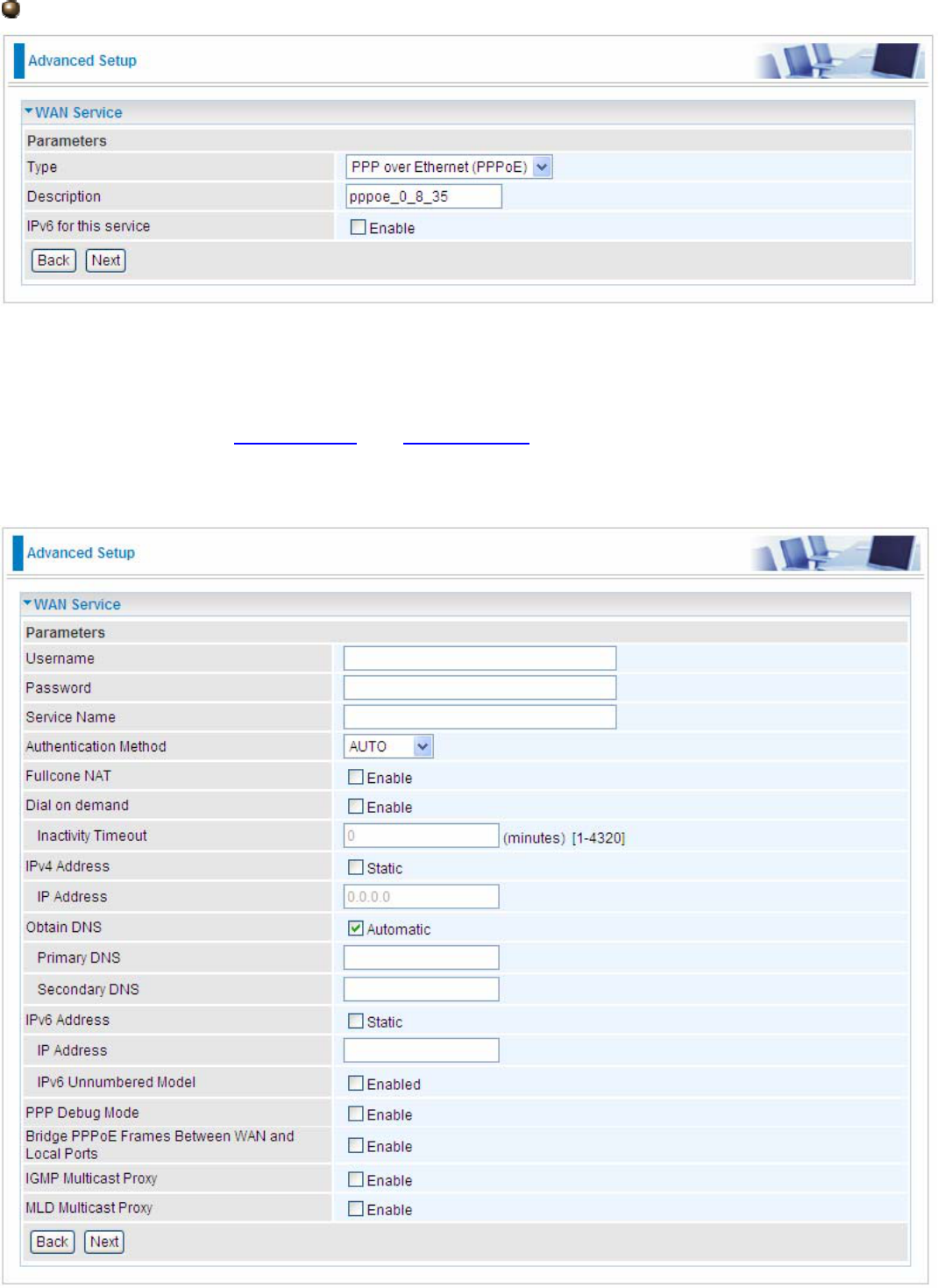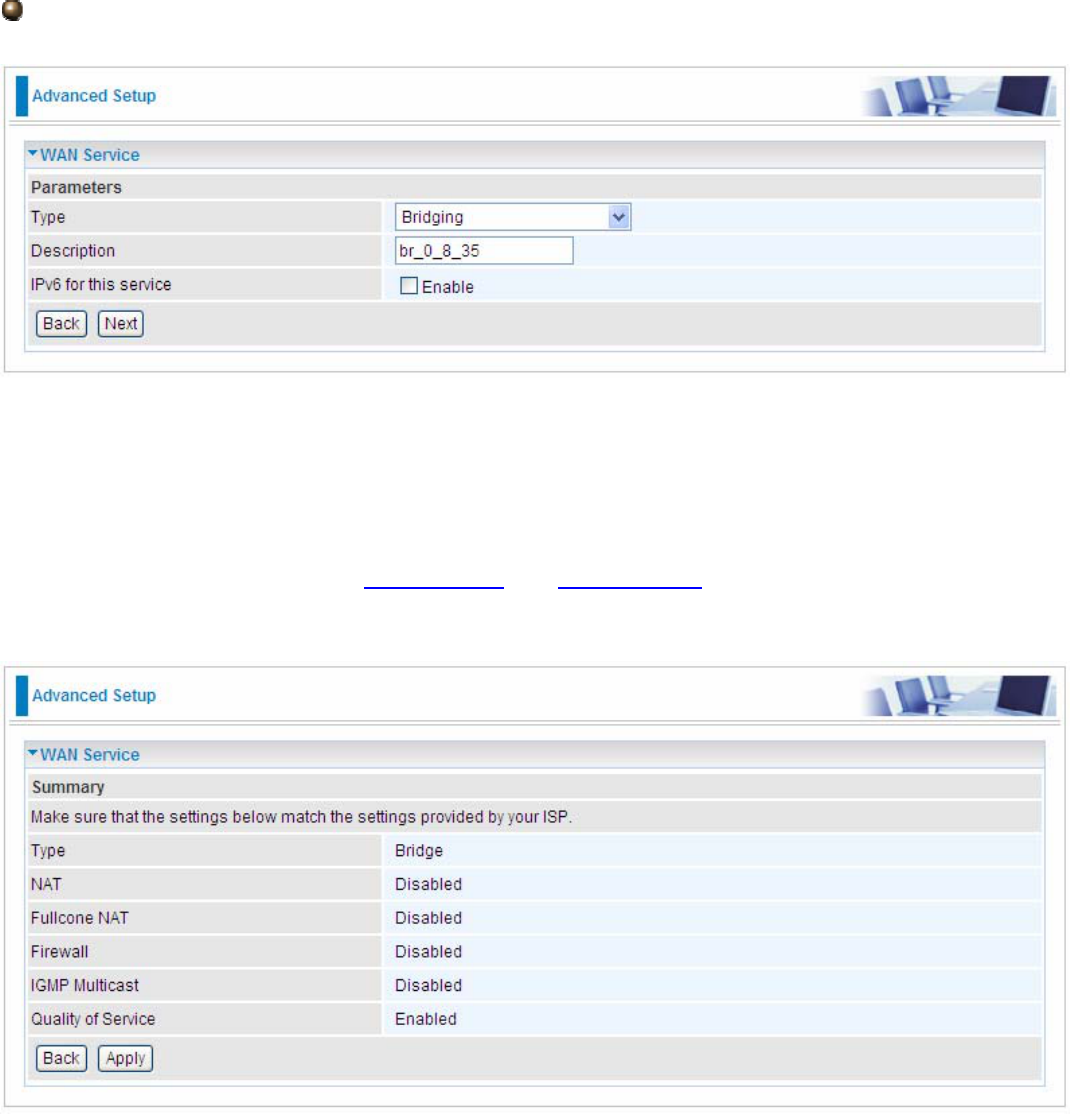Billion Electric BIL-7800NEX 3G/Wireless-N Dual WAN ADSL2+ Firewall Router User Manual 1
Billion Electric Co., Ltd. 3G/Wireless-N Dual WAN ADSL2+ Firewall Router Users Manual 1
Contents
- 1. Users Manual-1
- 2. Users Manual-2
Users Manual-1

BiPAC 7800NEXL
3G / Wireless-N Dual WAN ADSL2+
Firewall Router
User Manual
Version released: 2.02a.dc1 Last revised date: 11-19-2010
Table of Contents
Chapter 1: Introduction ..................................................................................................................1
Introduction to your Router......................................................................................................1
Features ..................................................................................................................................4
ADSL Compliance...................................................................................................................................................................4
Network Protocols and Features ..........................................................................................................................................4
Firewall.........................................................................................................................................................................................5
Quality of Service Control........................................................................................................................................................5
ATM, PTM and PPP Protocols.............................................................................................................................................5
IPTV Applications......................................................................................................................................................................6
Wireless LAN.............................................................................................................................................................................6
Management.............................................................................................................................................................................6
Hardware Specifications..........................................................................................................7
Physical Interface......................................................................................................................................................................7
Chapter 2: Installing the Router .....................................................................................................8
Package Contents ...................................................................................................................8
Important note for using this router..........................................................................................9
Device Description.................................................................................................................10
The Front LEDs.......................................................................................................................................................................10
The Rear Ports........................................................................................................................................................................11
Cabling ..................................................................................................................................12
Chapter 3: Basic Installation ........................................................................................................13
Connecting Your Router.........................................................................................................14
Network Configuration...........................................................................................................15
Configuring PC in windows 7...............................................................................................................................................15
Configuring PC in Windows Vista......................................................................................................................................17
Configuring PC in Windows XP..........................................................................................................................................19
Configuring PC in Windows 2000......................................................................................................................................20
Configuring PC in Windows 95/98/Me..............................................................................................................................21
Configuring PC in Windows NT4.0....................................................................................................................................22
Factory Default Settings ........................................................................................................23
Information from your ISP......................................................................................................25
Configuration via Web Interface ............................................................................................26
Chapter 4: Configuration..............................................................................................................27
Device Info ............................................................................................................................28
Summary..................................................................................................................................................................................29
WAN..........................................................................................................................................................................................30
Statistics.....................................................................................................................................................................................31
LAN...........................................................................................................................31
WAN Service.............................................................................................................31
xTM...........................................................................................................................32
xDSL .........................................................................................................................33
Route.........................................................................................................................................................................................36
ARP ...........................................................................................................................................................................................37
DHCP........................................................................................................................................................................................38
Quick Start.............................................................................................................................39
Advanced setup.....................................................................................................................43
WAN-Wide Area Network....................................................................................................................................................44
WAN Interface...........................................................................................................44
WAN Service.............................................................................................................49
LAN - Local Area Network....................................................................................................................................................72
IPv6 Autoconfig.........................................................................................................75
NAT............................................................................................................................................................................................78
Virtual Servers ..........................................................................................................78
ALG...........................................................................................................................81
DMZ Host..................................................................................................................82
Security......................................................................................................................................................................................83
Packet Filter..............................................................................................................83
Parental Control.......................................................................................................................................................................86
Time Restriction........................................................................................................86
URL Filter..................................................................................................................87
QoS - Quality of Service........................................................................................................................................................90
Queue Config............................................................................................................92
QoS Classification.....................................................................................................95
Routing................................................................................................................................................................................... 104
Default Gateway .....................................................................................................104
Static Route ............................................................................................................105
Policy Routing.........................................................................................................107
RIP..........................................................................................................................108
DNS........................................................................................................................................................................................ 109
IPv6 DNS Server.....................................................................................................109
Dynamic DNS ......................................................................................................... 110
DSL......................................................................................................................................................................................... 111
UPnP...................................................................................................................................................................................... 113
DNS Proxy............................................................................................................................................................................ 120
Interface Grouping............................................................................................................................................................... 121
Certificate ............................................................................................................................................................................... 123
Multicast ................................................................................................................................................................................. 126
Wireless...............................................................................................................................128
Basic ....................................................................................................................................................................................... 129
Security................................................................................................................................................................................... 131
MAC Filter.............................................................................................................................................................................. 145
Wireless Bridge .................................................................................................................................................................... 146
Advanced .............................................................................................................................................................................. 148
Station Info.............................................................................................................................................................................150
Management .......................................................................................................................151
System Log........................................................................................................................................................................... 152
SNMP Agent ........................................................................................................................................................................ 154
TR- 069 Client....................................................................................................................................................................... 155
Internet Time......................................................................................................................................................................... 157
Mail Alert................................................................................................................................................................................. 158
Wake on LAN....................................................................................................................................................................... 159
Access Control..................................................................................................................................................................... 160
Remote Access ................................................................................................................................................................... 161
Update Software.................................................................................................................................................................. 162
Backup / Update.................................................................................................................................................................. 163
Restart.................................................................................................................................164
Chapter 5: Troubleshooting........................................................................................................165
Appendix: Product Support & Contact .......................................................................................167
1
Chapter 1: Introduction
Introduction to your Router
Thank you for purchasing BiPAC 7800NEXL router, an all-in-one ADSL2+ Router with wireless-N
technology. The BiPAC 7800NEXL is an ADSL2+ Router that offers users affordable expanded
wireless coverage and speedy Internet connection. By supporting Internet Protocol, IPv6, this All-in-
One Router allows users to make internet connections between existing IPv4 networks and future
IPv6 network upgrades when greater security, high quality QoS and larger addressing are required.
With an integrated 802.11n Access Point, the BiPAC 7800NEXL can automatically adopt an optimal
connection to deliver smooth, constant signal reception even if obstacles are present. Robust
Firewall security is featured to protect Internet access against hacker attacks. The Quality of
Service and VLAN enables intelligent steaming for HD video or multiple applications such as music
downloads, online gaming, video streaming and file sharing simultaneously.
Optimal Wireless Speeds and Coverage
With an integrated 802.11n Wireless Access Point, this router supports a data rates up to 300Mbps
and delivers up to 6 times the speed and 3 times the wireless coverage of an 802.11b/g network
device. If the network requires wider coverage, the built-in Wireless Distribution System (WDS)
repeater function allows users to expand the wireless network without the need for any external
wires or cables.
Jitter-free, Reliable Net Traffic
Quality of Service (QoS) gives full control over outgoing data traffic. Priority can be assigned by the
router to ensure that important transmissions like gaming packets, VoIP calls or IPTV / streaming
content passes through the router at lightning speed, even when there is heavy Internet traffic. The
transfer speed of different types of outgoing data passing through the router is also controlled to
ensure that users do not saturate bandwidth with their browsing activities. The VLAN support is also
capable of establishing reliable high-speed transmissions for wide bandwidth applications such as
IPTV, VOD, or online gaming without consuming bandwidth.
High-speed Internet Access
The BiPAC 7800NEXL is compliant with worldwide ADSL standards, and supports download rates
of up to 12 / 24Mbps using ADSL2 / 2+, 8Mbps using ADSL and an upload rate of up to 1Mbps.
The integrated Annex M standard supports ADSL2 / 2+ for higher uploads by doubling the upload
data rate. The 4-port Ethernet Switch incorporated into the BiPAC 7800NEXL enables users to
connect to multiple computers or wired-Ethernet devices easily and enjoy blistering LAN
transmission for multimedia applications such as interactive gaming, IPTV video streaming and
real-time audio.
Simple Setup, Ease of Management
Easy Sign-On (EZSO), WPS push button and Auto-scan ADSL settings allow users to manage the
device functions effortlessly! The user-friendly, web-based user interface makes installing and
managing the BiPAC 7800NEXL extremely easy. With support for both DHCP client and server,
system administrators can manage IP assignment without having to reconfigure other stations and
fitting the router into existing network environments.
2
IPv6 supported
Internet Protocol version 6 (IPv6) is a version of the Internet Protocol that is designed to succeed
IPv4. IPv6 has a vastly larger address space than IPv4. This results from the use of a 128-bit
address, whereas IPv4 uses only 32 bits. The new address space thus supports 2128 (about
3.4×1038) addresses. This expansion provides flexibility in allocating addresses and routing traffic
and eliminates the primary need for network address translation (NAT), which gained widespread
deployment as an effort to alleviate IPv4 address exhaustion.
IPv6 also implements new features that simplify aspects of address assignment (stateless address
autoconfiguration) and network renumbering (prefix and router announcements) when changing
Internet connectivity providers. The IPv6 subnet size has been standardized by fixing the size of the
host identifier portion of an address to 64 bits to facilitate an automatic mechanism for forming the
host identifier from Link Layer media addressing information (MAC address).
Network security is integrated into the design of the IPv6 architecture. Internet Protocol Security
(IPsec) was originally developed for IPv6, but found widespread optional deployment first in IPv4
(into which it was back-engineered). The IPv6 specifications mandate IPsec implementation as a
fundamental interoperability requirement.
VLAN MUX
A Virtual LAN, commonly known as a VLAN, is a group of hosts with the common set of requirements
that communicate as if they were attached to the same broadcast domain, regardless of the physical
location. A VLAN has the same attributes as a physical LAN, but it allows for end stations to be
grouped together even if they are not located on the same network switch.
The most commonly used Virtual LAN is defined by 802.1Q tagging protocol, which expended the
original Ethernet frame header to include VLAN ID (tag) and priority bits. With the support of
network equipments, multiple virtual networks can coexist over the same physical network. Ethernet
frames are used to transfer data over ADSL line when bridging, MER or PPPoE mode is used.
While the DSL connection we usually configured is to use a PVC match a single service, PPPoE
PPPoA, bridging, etc. With the VLAN tag, we can make virtual interfaces to create multiple separate
WAN connections within the same PVC. It allows multiple services over the same PVC. The VLAN
Mux feature is designed for this purpose. For example, you have an ATM interface, PVC with
VPI/VCI 8/35, you can set the PPPoE, IPoE, and Bridge connection via the PVC without
respectively assigning the three services to three different PVCs.
Virtual AP
A “Virtual Access Point” is a logical entity that exists within a physical Access Point (AP). When a
single physical AP supports multiple “Virtual APs”, each Virtual AP appears to stations (STAs) to be
an independent physical AP, even though only a single physical AP is present. For example,
multiple Virtual APs might exist within a single physical AP, each advertising a distinct SSID and
capability set. Alternatively, multiple Virtual APs might advertise the same SSID but a different
capability set – allowing access to be provided via Web Portal, WEP, and WPA simultaneously.
Where APs are shared by multiple providers, Virtual APs provide each provider with separate
authentication and accounting data for their users, as well as diagnostic information, without
sharing sensitive management traffic or data between providers. You can enable the virtual AP.
Web Based GUI
It supports web based GUI for configuration and management. It is user-friendly and comes with
online help. It also supports remote management capability for remote users to configure and
manage this product.
3
Firmware Upgradeable
Device can be upgraded to the latest firmware through the WEB based GUI.
4
Features
• IPv6 ready (IPv4/IPv6 dual stack)
• Supports Multiple LAN segment for multiple network application
• 4-port 10 / 100Mbps Ethernet switch integrated
• High-speed Internet Access via ADSL2 / 2+; Backward Compatible with ADSL
• 802.11n Wireless Access Point with Wi-Fi Protected Setup (WPS), Wi-Fi Protected
Access (WPA-PSK/ WPA2-PSK) and Wired Equivalent Privacy (WEP) support
• Wireless speed up to 300Mbps
• Quality of Service Control for traffic prioritization and bandwidth management
• SOHO Firewall security with DoS Prevention and Packet Filtering
• Universal Plug and Play (UPnP) Compliance
• Dynamic Domain Name System (DDNS)
• Available Syslog
• Ease of Use with Quick Installation Wizard and Auto-scan ADSL settings
• Supports IPTV Application*2
• Easy Sign-On (EZSO)
ADSL Compliance
• Compliant with ADSL Standard
- Full-rate ANSI T1.413 Issue 2
- G.dmt (ITU G.992.1)
- G.lite (ITU G.992.2)
- G.hs (ITU G.994.1)
- ADSL over ISDN / U-R2
• Compliant with ADSL2 Standard
- G.dmt.bis (ITU G.992.3)
- ADSL2 Annex M (ITU G.992.3 Annex M) (BiPAC 7800NEXL A only)
• Compliant with ADSL2+ Standard
- G.dmt.bis plus (ITU G.992.5)
- ADSL2+ Annex M (ITU G.992.5 Annex M) (BiPAC 7800NEXL A only)
Network Protocols and Features
• IPv4 or IPv4 / IPv6 Dual Stack
• NAT, static (v4/v6) routing and RIP-1 / 2
• IPv6 Stateless/ Stateful Address Auto-configuration
• IPv6 Router Advertisement
• IPv6 over PPP
5
• DHCPv6
• Universal Plug and Play (UPnP) Compliant
• Dynamic Domain Name System (DDNS)
• Virtual Server and DMZ
• SNTP, DNS relay and IGMP proxy
• IGMP snooping for video service
• Management based-on IP protocol, port number and address
Firewall
• Built-in NAT Firewall
• Stateful Packet Inspection (SPI)
• Prevents DoS attacks including Land Attack, Ping of Death, etc.
• Remote access control for web base access
• Packet Filtering (v4/v6) - port, source IP address, destination IP address, MAC address
• URL Content Filtering - string or domain name detection in URL string
• Password protection for system management
• VPN pass-through
Quality of Service Control
• Supports the DiffServ approach
• Traffic prioritization and bandwidth management based-on IP protocol, port number
and address
ATM, PTM and PPP Protocols
• ATM Adaptation Layer Type 5 (AAL5)
• Classical IP over ATM (IPoA) (RFC 2225 / RFC 1577)
• Bridged or routed Ethernet encapsulation
• VC and LLC based multiplexing
• PPP over Ethernet (PPPoE)
• PPP over ATM (RFC 2364)
• MAC Encapsulated Routing (RFC 1483 MER)
• OAM F4 / F5

6
IPTV Applications*2
• Virtual LAN (VLAN)
• Quality of Service (QoS)
• IGMP Snooping & IGMP Proxy
• MLD Snooping & proxy
• VLAN MUX support
Wireless LAN
• Compliant with IEEE 802.11n, 802.11g and 802.11b standards
• 2.4 GHz - 2.484 GHz frequency range
• Up to 300Mbps wireless operation rate
• 64 / 128 bits WEP supported for encryption
• WPS (Wi-Fi Protected Setup) for easy setup
• Wireless Security with WPA-PSK / WPA2-PSK support
• WDS repeater function support
• 802.1x radius supported
• Web-based GUI for WLAN on/off switch
Management
• Easy Sign-On (EZSO) and Auto-scan ADSL settings
• Web-based GUI for remote and local management (IPv4 / IPv6)
• Firmware upgrades and configuration data upload and download via web-based GUI
• Embedded Telnet server for remote and local management
• Available Syslog
• Mail alert for WAN IP changed
• Wake on LAN
• Supports DHCP server / client / relay
• TR-069*3 supports remote management
• SNMP v1/v2/V3 supports remote and local management
7
Hardware Specifications
Physical Interface
• WLAN: 2 x 2dbi detachable antennas
• DSL: ADSL port
• Ethernet: 4-port 10 / 100Mbps auto-crossover (MDI / MDI-X) Switch
• Factory default reset button
• WPS push button
• Power jack
• Power switch
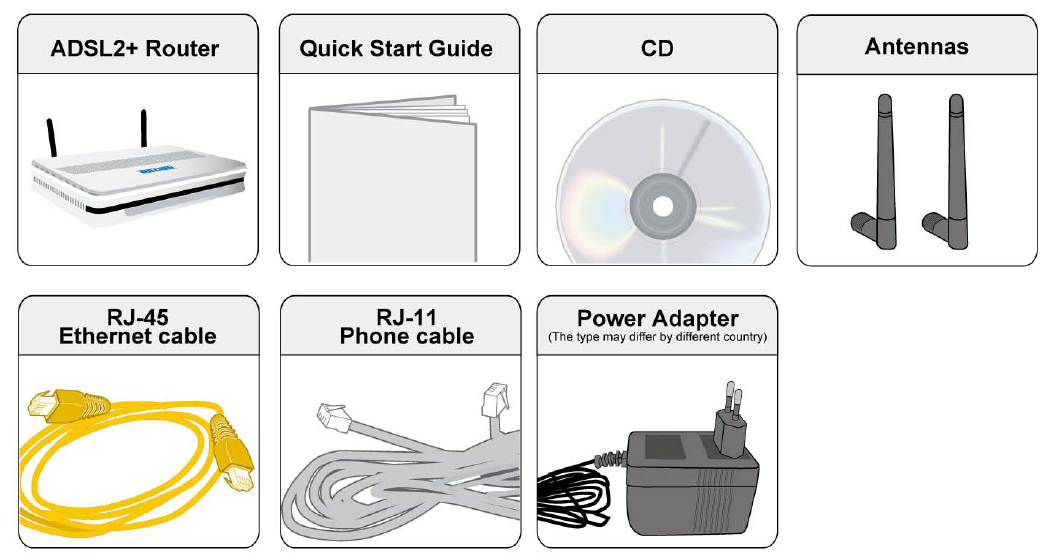
8
Chapter 2: Installing the Router
Package Contents
• BiPAC 7800NEXL 3G / Wireless-N Dual WAN ADSL2+ Firewall Router
• Quick Start Guide
• CD containing the on-line manual
• Two 2dBi detachable antennas
• Ethernet (RJ-45) cable
• RJ-11 ADSL/ telephone cable
• Power adapter
• Splitter / Micro-filter (Optional)
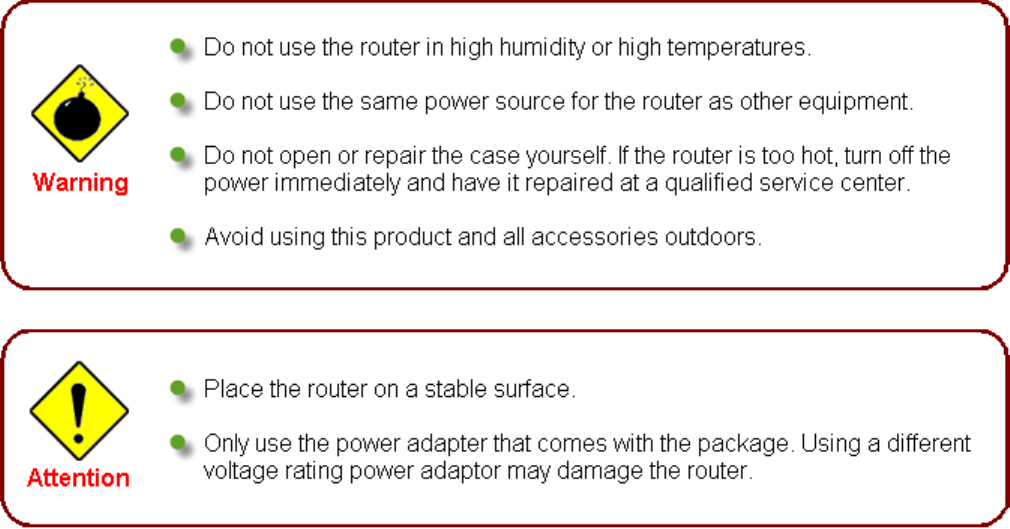
9
Important note for using this router

10
Device Description
The Front LEDs
LED Meaning
1 Internet
Lit red when WAN port fails to get IP address.
Lit green when WAN port gets IP address successfully.
Unlit when the device is in bridge mode or WAN connection is
absent.
2 DSL
Lit green when the device is successfully connected to an ADSL
DSLAM. (“line sync”)
3 WPS Flash green when WPS configuration is in progress.
Unlit when WPS fails.
4 Wireless Lit green when a wireless connection is established.
Unlit when wireless is disabled.
5
Ethernet port
1X - 4X
(RJ-45 connector)
Lit green when successfully connected to an Ethernet device.
Blinking when data is being transmitted / received.
6 Power
When the system is ready, it will be lit green.
Lit red when the device fails to boot or when the device is in
emergency mode
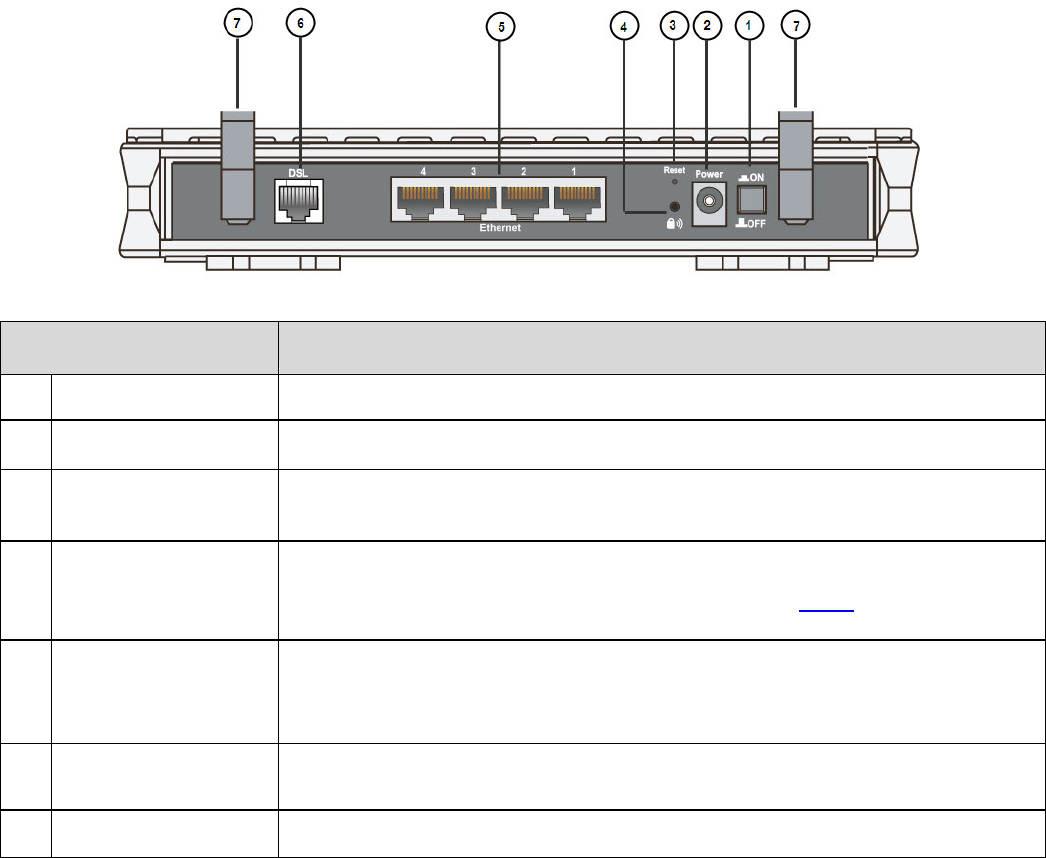
11
The Rear Ports
Port Meaning
1 Power Switch Power ON/OFF switch.
2
Power
Connect it with the supplied power adapter.
3 Reset
Press for more than 5 seconds to restore the device to its factory
default mode.
4 WPS
Push WPS button to trigger Wi-Fi Protected Setup function.
For WPS configuration details, please refer to WPS Setup section o
f
this User Manual.
5
Ethernet Connect your computer to a LAN port using the included Ethernet cable
(with RJ-45 cable)
6 DSL Connect the supplied RJ-11 cable to this port when connecting to the
ADSL/telephone network
7 Wireless Antenna Connect the detachable antenna for wireless connection.
12
Cabling
One of the most common causes of problem is bad cabling or ADSL line(s). Make sure that all
connected devices are turned on. On the front panel of your router is a bank of LEDs. Verify that the
LAN Link and ADSL line LEDs are lit. If they are not, verify if you are using the proper cables. If the
error persists, you may have a hardware problem. In this case you should contact technical support.
Ensure that all other devices connected to the same telephone line as your router (e.g. telephones,
fax machines, analogue modems) have a line filter connected between them and the wall socket
(unless you are using a Central Splitter or Central Filter installed by a qualified and licensed
electrician), and ensure that all line filters are correctly installed and the right way around. Missing
line filters or line filters installed the wrong way around can cause problems with your ADSL
connection, including causing frequent disconnections. If you have a back-to-base alarm system you
should contact your security provider for a technician to make any necessary changes.

13
Chapter 3: Basic Installation
The router can be configured through your web browser. A web browser is included as a standard
application in the following operating systems: Linux, Mac OS, Windows 7 / 98 / NT / 2000 / XP / Me
/ Vista, etc. The product provides an easy and user-friendly interface for configuration.
Please check your PC network components. The TCP/IP protocol stack and Ethernet network
adapter must be installed. If not, please refer to your Windows-related or other operating system
manuals.
There are ways to connect the router, either through an external repeater hub or connect directly
to your PCs. However, make sure that your PCs have an Ethernet interface installed properly prior
to connecting the router device. You ought to configure your PCs to obtain an IP address through
a DHCP server or a fixed IP address that must be in the same subnet as the router. The default IP
address of the router is 192.168.1.254 and the subnet mask is 255.255.255.0 (i.e. any attached PC
must be in the same subnet, and have an IP address in the range of 192.168.1.1 to 192.168.1.253).
The best and easiest way is to configure the PC to get an IP address automatically from the router
using DHCP. If you encounter any problem accessing the router web interface it is advisable to
uninstall your firewall program on your PCs, as they can cause problems accessing the IP address
of the router. Users should make their own decisions on what is best to protect their network.
Please follow the following steps to configure your PC network environment.
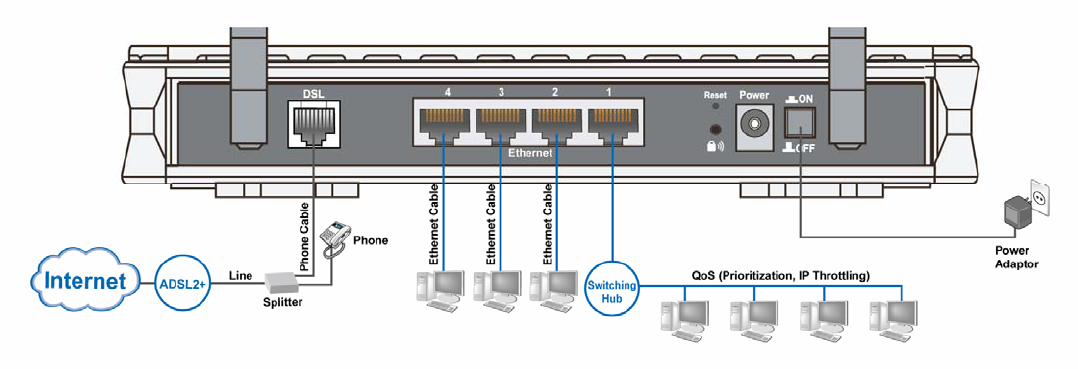
14
Connecting Your Router
Users can connect the ADSL2+ router as the following.
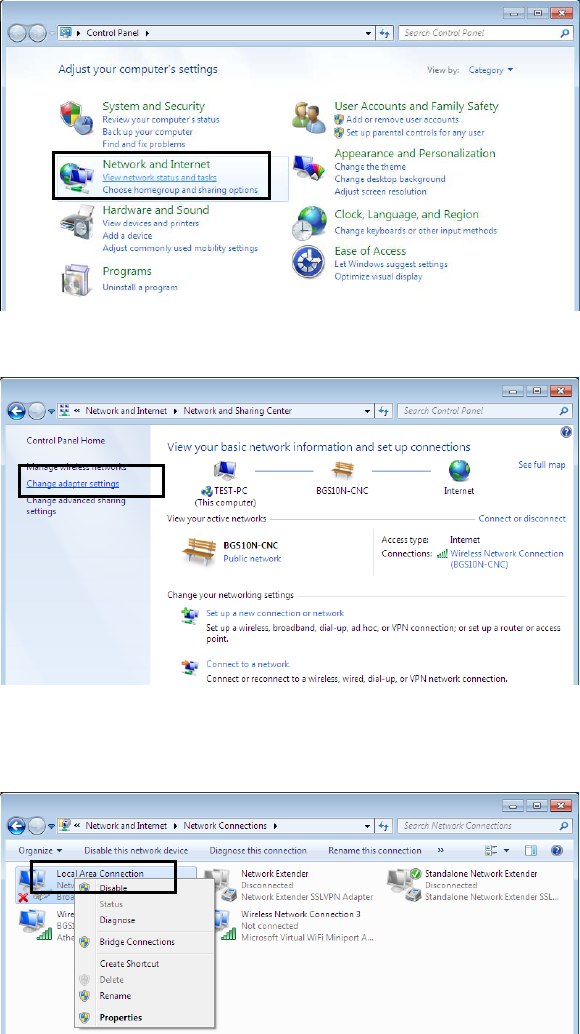
15
Network Configuration
Configuring PC in windows 7
1. Go to Start. Click on Control Panel.
Then click on Network and Internet.
2. When the Network and Sharing
Center window pops up, select and click
on Change adapter settings on the left
window panel.
3. Select the Local Area Connection,
and right click the icon to select
Properties.
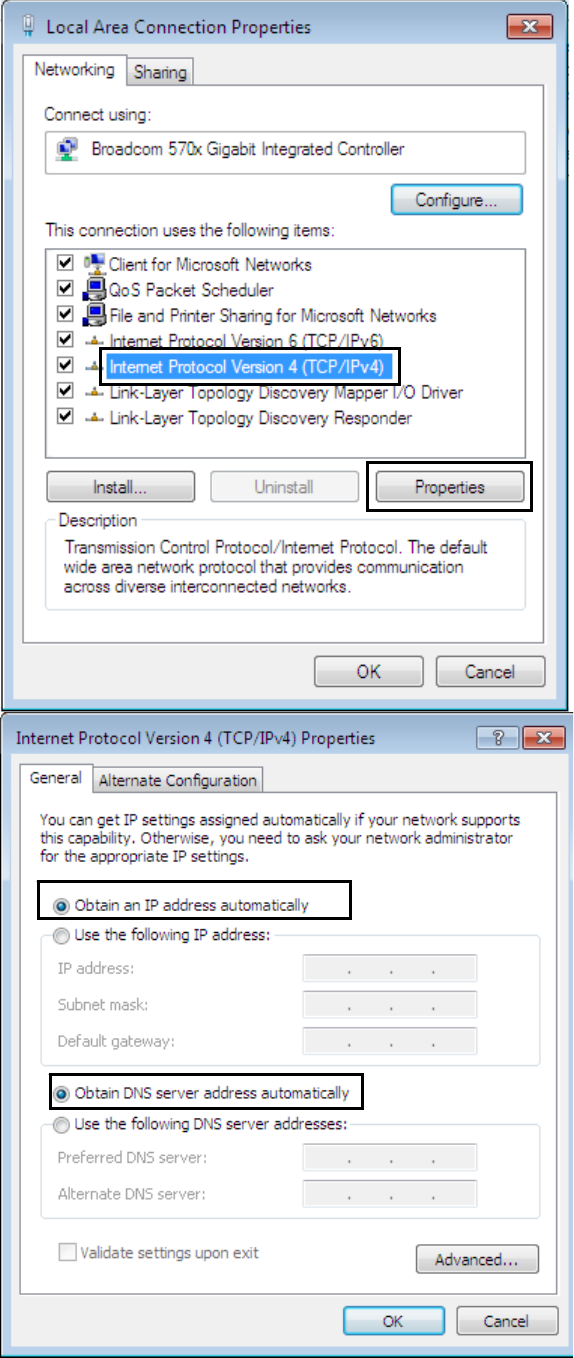
16
4. Select Internet Protocol Version 4
(TCP/IPv4) then click Properties.
5. In the TCP/IPv4 properties window,
select the Obtain an IP address
automatically and Obtain DNS Server
address automatically radio buttons.
Then click OK to exit the setting.
6. Click OK again in the Local Area
Connection Properties window to
apply the new configuration.
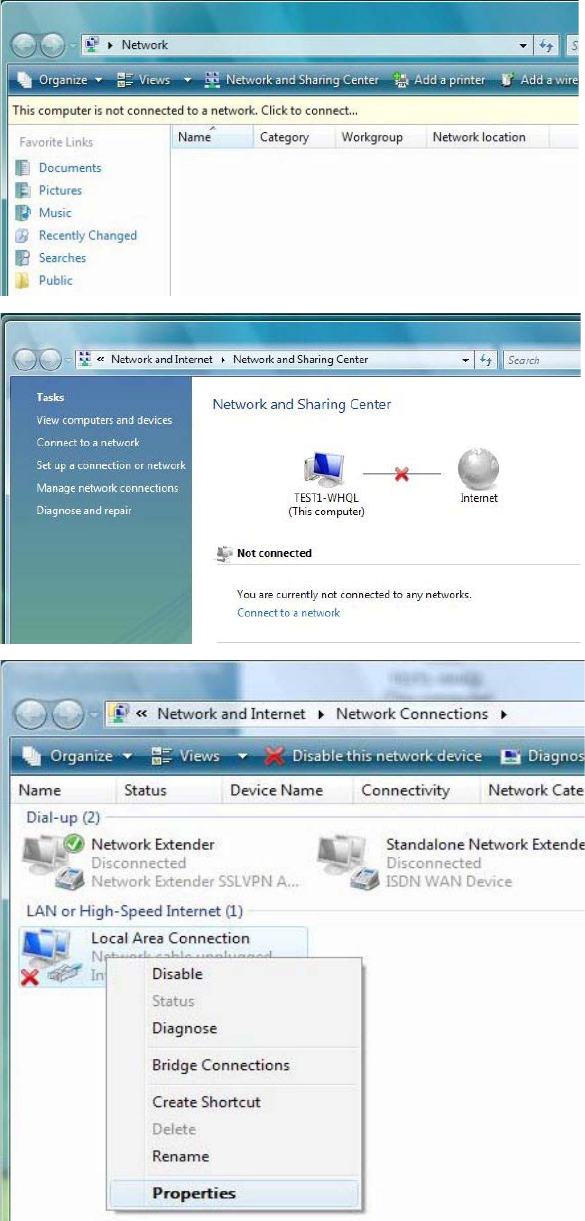
17
Configuring PC in Windows Vista
1. Go to Start. Click on Network.
2. Then click on Network and Sharing
Center at the top bar.
3. When the Network and Sharing Center
window pops up, select and click on
Manage network connections on the left
window column.
4. Select the Local Area Connection,
and right click the icon to select Properties..
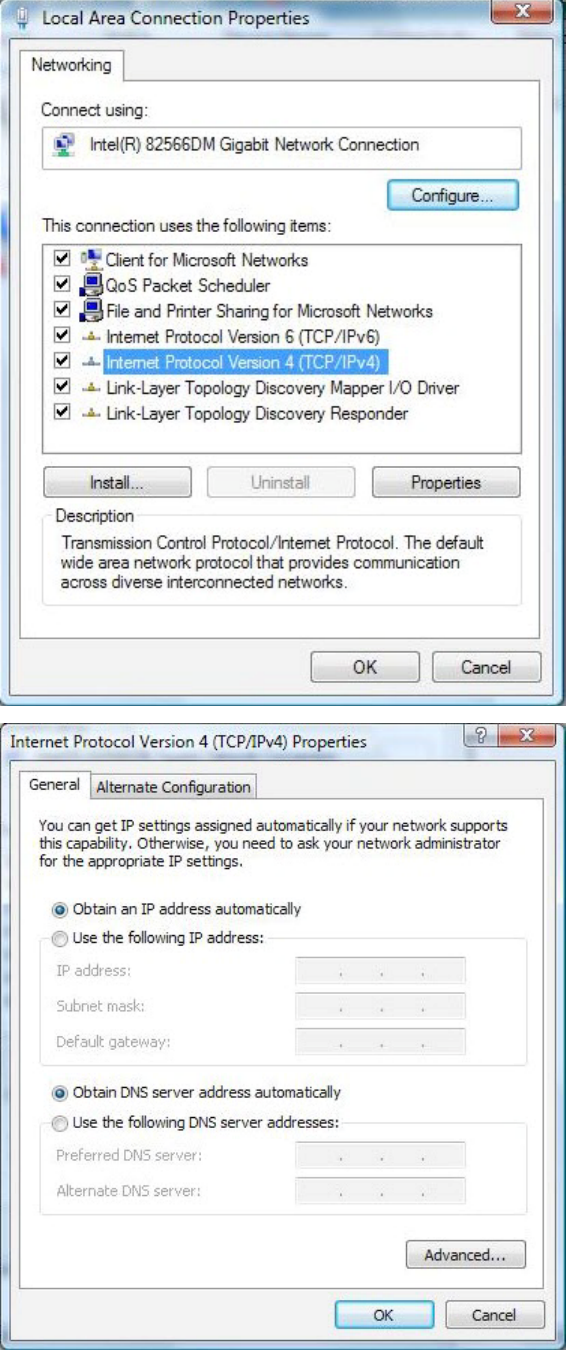
18
5. Select Internet Protocol Version 4
(TCP/IPv4) then click Properties.
6. In the TCP/IPv4 properties window,
select the Obtain an IP address
automatically and Obtain DNS Server
address automatically radio buttons.
Then click OK to exit the setting.
7. Click OK again in the Local Area
Connection Properties window to apply
the new configuration.
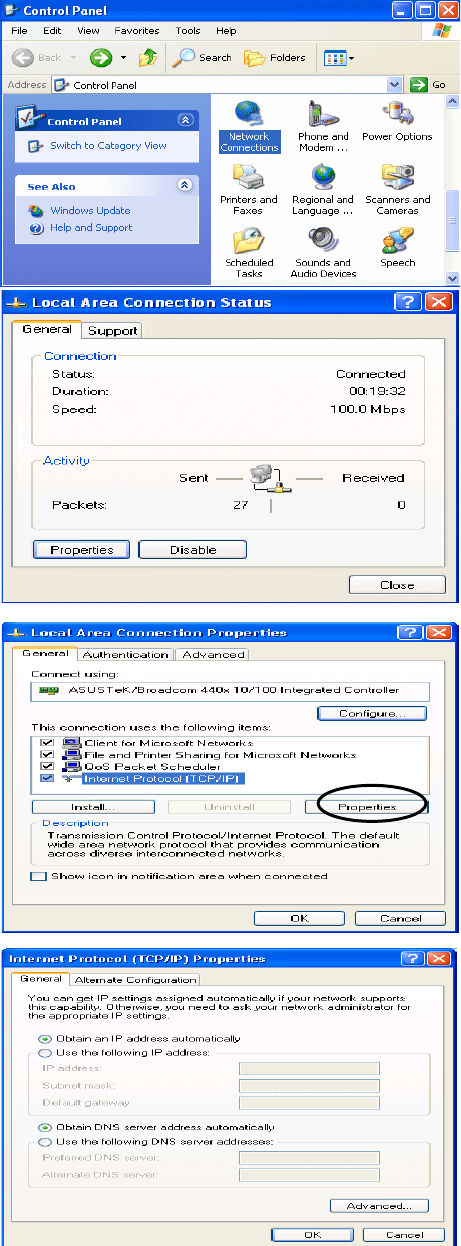
19
Configuring PC in Windows XP
1. Go to Start > Control Panel (in Classic
View). In the Control Panel, double-click on
Network Connections
2. Double-click Local Area Connection.
3. In the Local Area Connection Status
window, click Properties.
4. Select Internet Protocol (TCP/IP) and
click Properties.
5. Select the Obtain an IP address
automatically and the Obtain DNS server
address automatically radio buttons.
6. Click OK to finish the configuration.
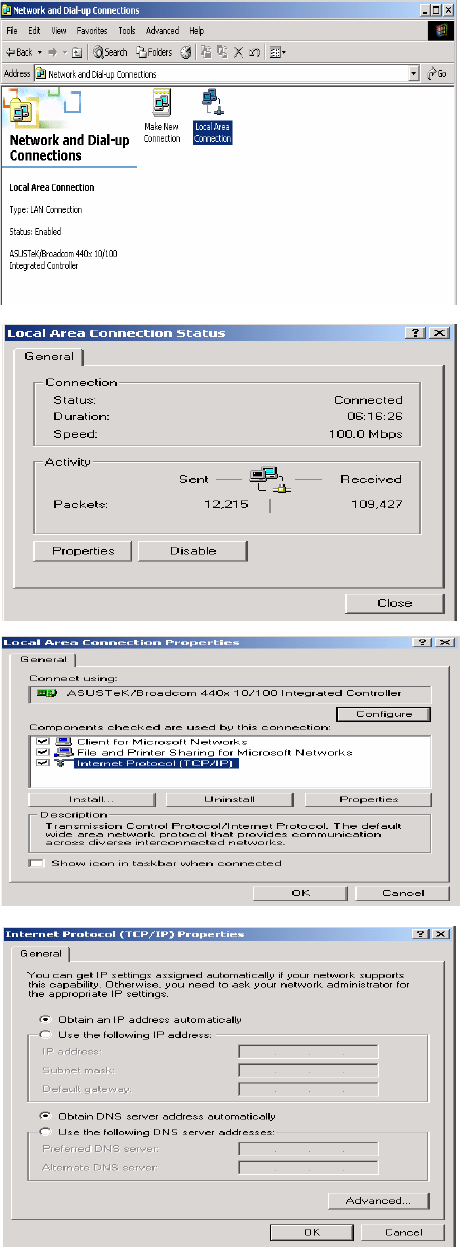
20
Configuring PC in Windows 2000
1. Go to Start > Settings > Control Panel.
In the Control Panel, double-click on Network
and Dial-up Connections.
2. Double-click Local Area Connection.
3. In the Local Area Connection Status
window click Properties.
4. Select Internet Protocol (TCP/IP) and
click Properties.
5. Select the Obtain an IP address
automatically and the Obtain DNS server
address automatically radio buttons.
6. Click OK to finish the configuration.
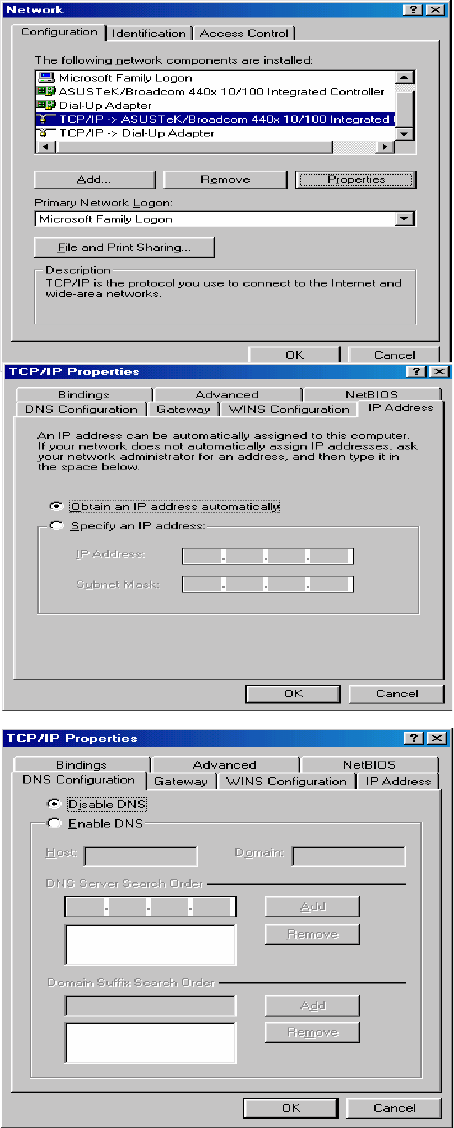
21
Configuring PC in Windows 95/98/Me
1. Go to Start > Settings > Control Panel.
In the Control Panel, double-click on
Network and choose the Configuration tab.
2. Select TCP/IP > NE2000 Compatible, or
the name of your Network Interface Card (NIC)
in your PC.
3. Select the Obtain an IP address
automatically radio button.
4. Then select the DNS Configuration tab.
5. Select the Disable DNS radio button
and click OK to finish the configuration.
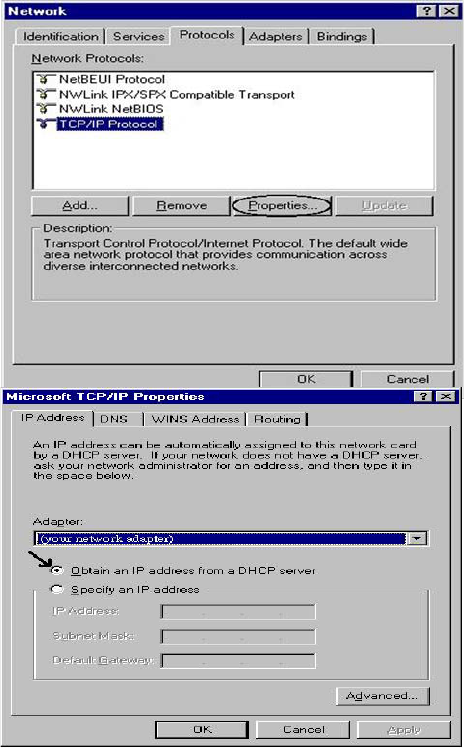
22
Configuring PC in Windows NT4.0
1. Go to Start > Settings > Control Panel.
In the Control Panel, double-click on Network
and choose the Protocols tab.
2. Select TCP/IP Protocol and click Properties.
3. Select the Obtain an IP address from a
DHCP server radio button and click OK.
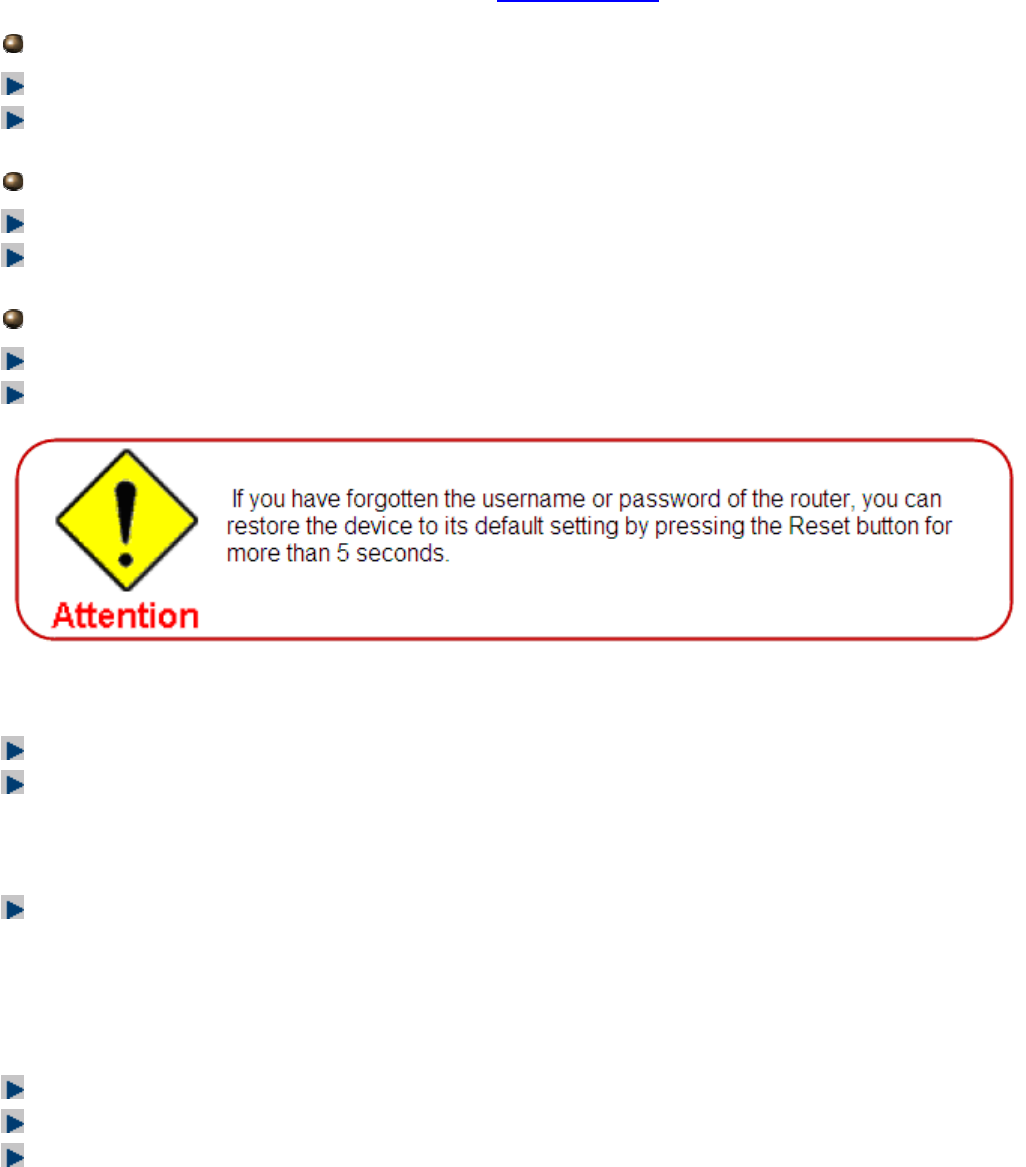
23
Factory Default Settings
Before configuring your router, you need to know the following default settings.
Web Interface (Username and Password)
Three user levels are provided by this router, thus Administrator, Remote and Local respectively.
(Note: Administrator admin, is enabled by default, but the other two users need to be enabled
through manual settings by administrator. See Access Control section.)
Administrator
Username: admin
Password: admin
Local
Username: user
Password: user
Remote
Username: support
Password: support
Device LAN IPv4 settings
IPv4 Address: 192.168.1.254
Subnet Mask: 255.255.255.0
Device LAN IPv6 settings
IPv6 Address / prefix: Default is a link-local address and is different from each other as MAC
address is different from one to one. For example: fe80:0000:0000:0000:0204:edff:fe01:0001 / 64,
the prefix initiates by fe80::
DHCP server for IPv4
DHCP server is enabled.
Start IP Address: 192.168.1.100
IP pool counts: 100

24
LAN and WAN Port Addresses
The parameters of LAN and WAN ports are pre-set in the factory. The default values are shown in
the table.
IPv4
LAN Port WAN Port
IPv4 address 192.168.1.254
Subnet Mask 255.255.255.0
DHCP server function Enabled
IP addresses for
distribution to PCs
100 IP addresses continuing
from 192.168.1.100 through
192.168.1.199
The PPPoE function is
enabled to automatically get
the WAN port configuration
from the ISP.
IPv6
LAN Port WAN Port
IPv6 address/prefix Default is a link-local address and is
different from each other as MAC
address is different from one to one.
For example :
fe80:0000:0000:0000:0204:edff:fe01:
0001/64, the prefix initiates by fe80::
DHCP server function Enabled
The PPPoE function is
enabled to automatically get
the WAN port configuration
from the ISP.

25
Information from your ISP
Before configuring this device, you have to check with your ISP (Internet Service Provider) to find
out what kind of service is provided such as DHCP (Obtain an IP Address Automatically, Static IP
(Fixed IP Address) or PPPoE.
Gather the information as illustrated in the following table and keep it for reference.
PPPoE(RFC2516)
VPI/VCI, VC / LLC-based multiplexing, Username, Password, Service
Name, and Domain Name System (DNS) IP address (it can be
automatically assigned by your ISP when you connect or be set manually).
PPPoA(RFC2364)
VPI/VCI, VC / LLC-based multiplexing, Username, Password and Domain
Name System (DNS) IP address (it can be automatically assigned by your
ISP when you connect or be set manually).
IPoA(RFC1577)
VPI/VCI, VC / LLC-based multiplexing, IP address, Subnet mask, Gateway
address, and Domain Name System (DNS) IP address (it is a fixed IP
address).
Pure Bridge
VPI/VCI, VC / LLC-based multiplexing to use Bridged Mode.
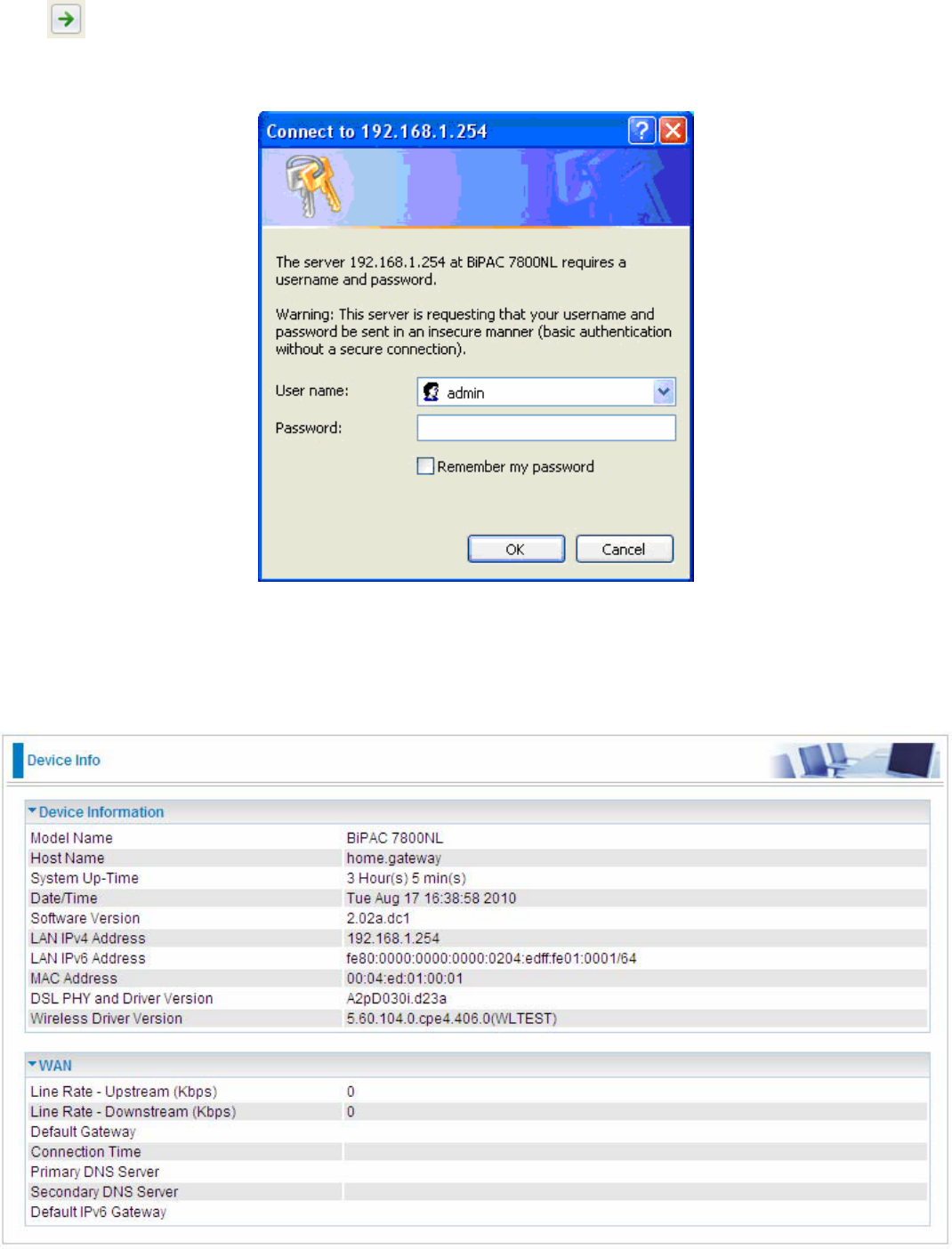
26
Configuration via Web Interface
Open your web browser; enter the IP address of your router, which by default is 192.168.1.254, and
click or press ‘Enter’ key on the keyboard, a login prompt window will appear. The default root
username and password are “admin” and “admin” respectively.
Congratulations! You are now successfully logged in to the Firewall Router!
If the authentication succeeds, the Status page below will appear on the screen.

27
Chapter 4: Configuration
Once you have logged on to your BiPAC 7800NEXL Router via your web browser, you can begin to
set it up according to your requirements. On the configuration homepage, the left navigation pane
links you directly to the setup pages, which include:
Device Info (Summary, WAN, Statistics, Route, ARP, DHCP)
Quick Start
Advanced Setup (WAN, LAN, NAT, Security, Parental Control, Quality of Service, Routing, DNS,
DSL, UPnP, DNS Proxy, Interface Grouping, Certificate, Multicast)
Wireless (Basic, Security, MAC Filter, Wireless Bridge, Advanced, Station Info)
Management (System Log, SNMP Agent, TR-069 Client, Internet Time, Mail Alert, Wake on LAN,
Access Control, Remote Access, Update Software, Backup/Update)
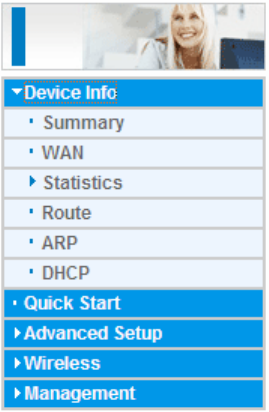
28
Device Info
This Section gives users an easy access to the information about the working router and view the
current status of the router. Here Summary, WAN, Statistics, Router, ARP and DHCP six
subsections are included.
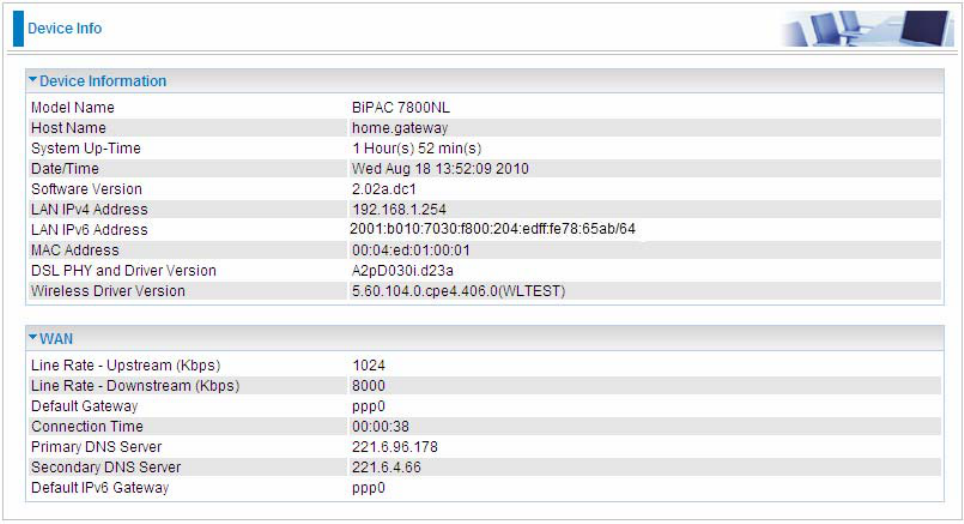
29
Summary
The basic information about the device is provided here (the following is a configured
screenshots to let users understand clearly).
Device Information
Model Name: Display the model name.
Host Name: Display the name of the router.
System Up-Time: Display the elapsed time since the device is on.
Date/Time: Display the current exact date and time.
Software Version: Firmware version.
LAN IPv4 Address: Display the LAN IPv4 address.
LAN IPv6 Address: Display the LAN IPv6 address. Default is a Link-Local address, but
when connects to ISP, it will display the Global Address, like above figure.
MAC Address: Display the MAC address.
DSL PHY and Driver Version: Display DSL PHY and Driver version.
Wireless Driver Version: Display wireless driver version.
WAN
Line Rate – Upstream (Kbps): Display Upstream line Rate in Kbps.
Line Rate – Downstream (Kbps): Display Downstream line Rate in Kbps.
Default Gateway: Display Default Gateway.
Connection Time: Display the elapsed time since ADSL connection is up.
Primary DNS Server: Display IPV4 address of Primary DNS Server.
Secondary DNS Server: Display IPV4 address of Secondary DNS Server.
Default IPv6 Gateway: Display the IPv6 Gateway used.

30
WAN
This table displays the information of the WAN connections, users can turn here for WAN connection
information.
Interface: the WAN connection interface.
Description: the description of this connection.
Type: the protocol used by this connection.
VlanMuxld: Show the status of the VLANMuxld, VLAN ID or disabled. If VLAN ID is -1, then
disabled is shown in this field, while if VLAN ID isn’t -1, the exact VLAN ID is shown here in this field.
Igmp: Display the status of IGMP, disabled or enabled.
NAT: Display the status of NAT, disabled or enabled.
Firewall: Display the status of Firewall, disabled or enabled.
Status: Display the status of this WAN connection.
IPv4 Address: the WAN IPv4 Address the device obtained.
IPv6 Address: the WAN IPv6 Address the device obtained.

31
Statistics
LAN
The table shows the statistics of LAN.
Interface: List each LAN interface. P1-P4 indicate the four LAN interfaces.
Bytes: Display the Received and Transmitted traffic statistics in Bytes.
Packets: Display the Received and Transmitted traffic statistics in Packets.
Errors: Display the statistics of errors arising in Receiving or Transmitting data.
Drops: Display the statistics of drops arising in Receiving or Transmitting data.
Reset: Press this button to get the latest information.
WAN Service
The table shows the statistics of LAN.
Interface: Display the connection interface.
Description: the description for the connection.
Bytes: Display the WAN Received and Transmitted traffic statistics in Bytes.
Packets: Display the WAN Received and Transmitted traffic statistics in Packests.
Errors: Display the statistics of errors arising in Receiving or Transmitting data.
Drops: Display the statistics of drops arising in Receiving or Transmitting data.
Reset: Press this button to get the latest information.

32
xTM
The Statistics-xTM screen displays all the xTM statistics
Port Number: Shows number of the port for xTM.
In Octets: Number of received octets over the interface.
Out Octets: Number of transmitted octets over the interface.
In Packets: Number of received packets over the interface.
Out Packets: Number of transmitted packets over the interface.
In OAM Cells: Number of OAM cells received.
Out OAM Cells: Number of OAM cells transmitted.
In ASM Cells: Number of ASM cells received.
Out ASM Cells: Number of ASM cells transmitted.
In Packet Errors: Number of received packets with errors.
In Cell Errors: Number of received cells with errors.
Reset: Click to reset the statistics.
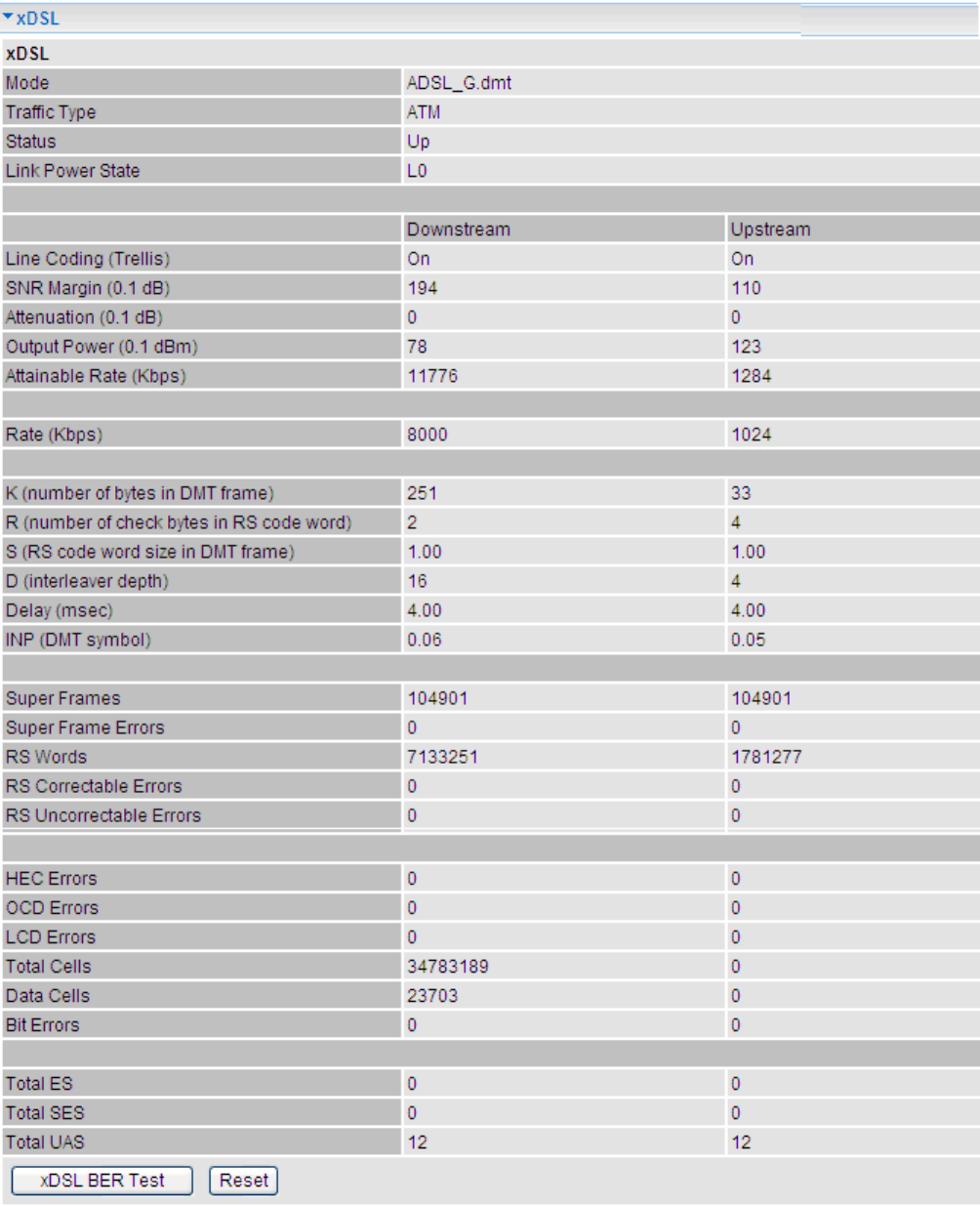
33
xDSL
Mode: Modulation protocol, including G.dmt, G.lite, T1.413, ADSL2, AnnexL, ADSL2+ and AnnexM.
Traffic Type: transfer mode, here supports ATM and PTM.
Status: Show the status of DSL link.
Link Power State: Show link output power state.
Line Coding (Trellis): Trellis on/off.
SNR Margin (0.1 dB): show the Signal to Noise Ratio(SNR) margin.
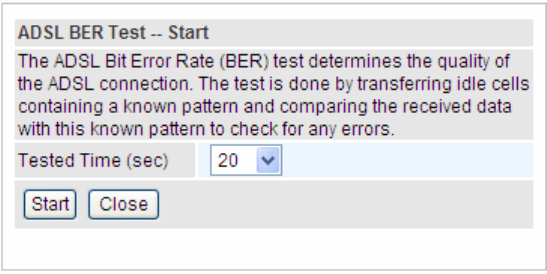
34
Attenuation (0.1 dB): This is estimate of average loop attenuation of signal.
Output Power (0.1 dBm): show the output power.
Attainable Rate (Kbps) : The sync rate you would obtain.
Rate (Kbps): show the downstream and upstream rate in Kbps.
K (number of bytes in DMT frame): show the number of bytes in DMT frame.
R (number of check bytes in RS code word): show the number of check bytes in RS code word.
S (RS code word size in DMT frame): show the RS code word size in DMT frame.
D (interleaver depth): show the interleaver depth.
Delay (msec): show the delay time in msec.
INP (DMT symbol): show the DMT symbol.
Super Frames: the total number of super frames.
Super Frame Errors: the total number of super frame errors.
RS Words: Total number of Reed-Solomon code errors.
RS Correctable Errors: Total number of RS with correctable errors.
RS Uncorrectable Errors: Total number of RS words with uncorrectable errors.
HEC Errors: Total number of Header Error Checksum errors.
OCD Errors: Total number of out-of-cell Delineation errors.
LCD Errors: Total number of Loss of Cell Delineation.
Total Cells: Total number of cells.
Data Cells: Total number of data cells.
Bit Errors: Total number of bit errors.
Total ES: Total Number of Errored Seconds.
Total SES: Total Number of Severely Errored Seconds.
Total UAS: Total Number of Unavailable Seconds.
xDSL BER Test: Click this button to start a bit Error Rate Test. The ADSL Bit Error Rate (BER) test
determines the quality of the ADSL connection. The test is done by transferring idle cells containing
a known pattern and comparing the received data with this known pattern to check for any errors.
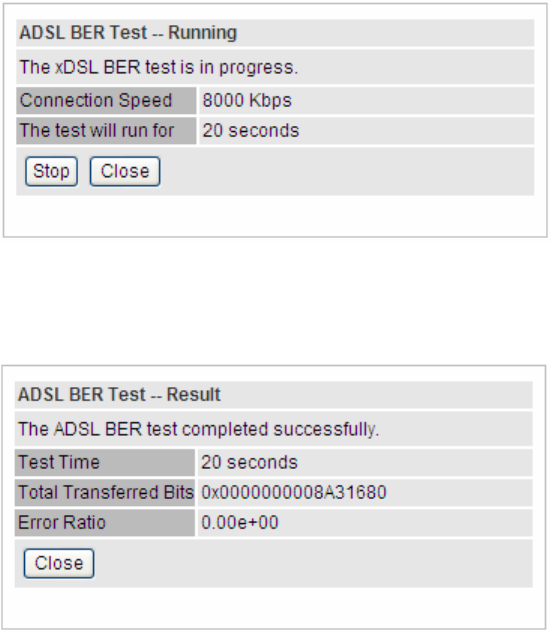
35
Select the Tested Time(sec), press Start to start test.
When it is OK, the following test result window will appear. You can view the quality of ADSL
connection. Here the connection is OK.
Reset : Click this button to reset the statistics.

36
Route
Destination: the IP address of destination network.
Gateway: the IP address of the gateway this route uses.
Subnet Mask: the destination subnet mask.
Flag: show the status of the route.
L U: show the route is activated or enabled.
L H (host): destination is host not the subnet.
L G: show that the outside gateway is needed to forward packets in this route.
L R: show that the route is reinstated from dynamic routing.
L D: show that the route is dynamically installed by daemon or redirecting.
L M: show the route is modified from routing daemon or redirect.
Metric: Display the number of hops counted as the Metric of the route.
Service: Display the service that this route uses.
Interface: Display the existing interface this route uses.

37
ARP
This section displays the router’s ARP (Address Resolution Protocol) Table, which shows the
mapping of Internet (IP) addresses to Ethernet (MAC) addresses. This is useful as a quick way of
determining the MAC address of the network interface of your PCs to use with the router’s Firewall –
MAC Address Filter function. See the Firewall section of this manual for more information on this
feature.
IP Address: Shows the IP Address of the device that the MAC address maps to.
Flag: Shows the current status of the ARP entries.
L Complete: the route resolving is processing well.
L M(Marked as permanent entry): the route is permanent.
L P (publish entry): publish this route item.
MAC Address: Shows the MAC address that is corresponded to the IP address of the device it is
mapped to.
Device: here refers to the physical interface, it is a concept to identify Clients from LAN or WAN. For
example, the Clients in LAN, here displays “br0”.

38
DHCP
The DHCP Table lists the DHCP lease information for all IP addresses assigned by the DHCP
server in the device.
IP Address: The IP address which is assigned to the host with this MAC address.
MAC Address: The MAC Address of internal DHCP client host.
Host Name: The Host Name of DHCP client.
Register Information: Show the remaining time information during registration.
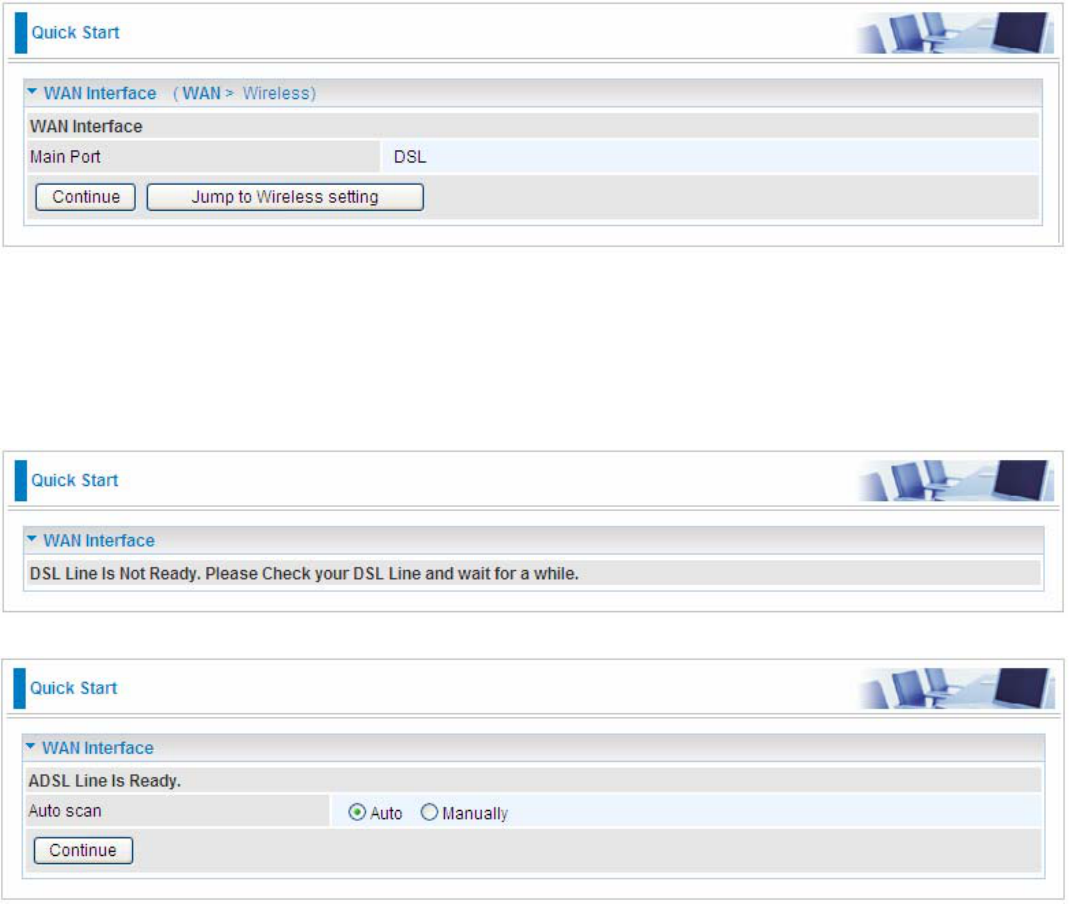
39
Quick Start
This part is to let you quickly configure and start your router to access internet.
1. To configure DSL, press Continue to go on to next step, or if you only want to configure Wireless,
press Jump to Wireless setting to go to step 8.
2. When ADSL line is not ready, the screen1 below will appear to remind you. Then you should
connect the ADSL line. While ADSL line is ready, the screen 2 below will appear to let you go on.
Here you can select Auto or Manually. Select Auto will go to step 3, and select manually will go to
step 4.
Screen 1
Screen 2
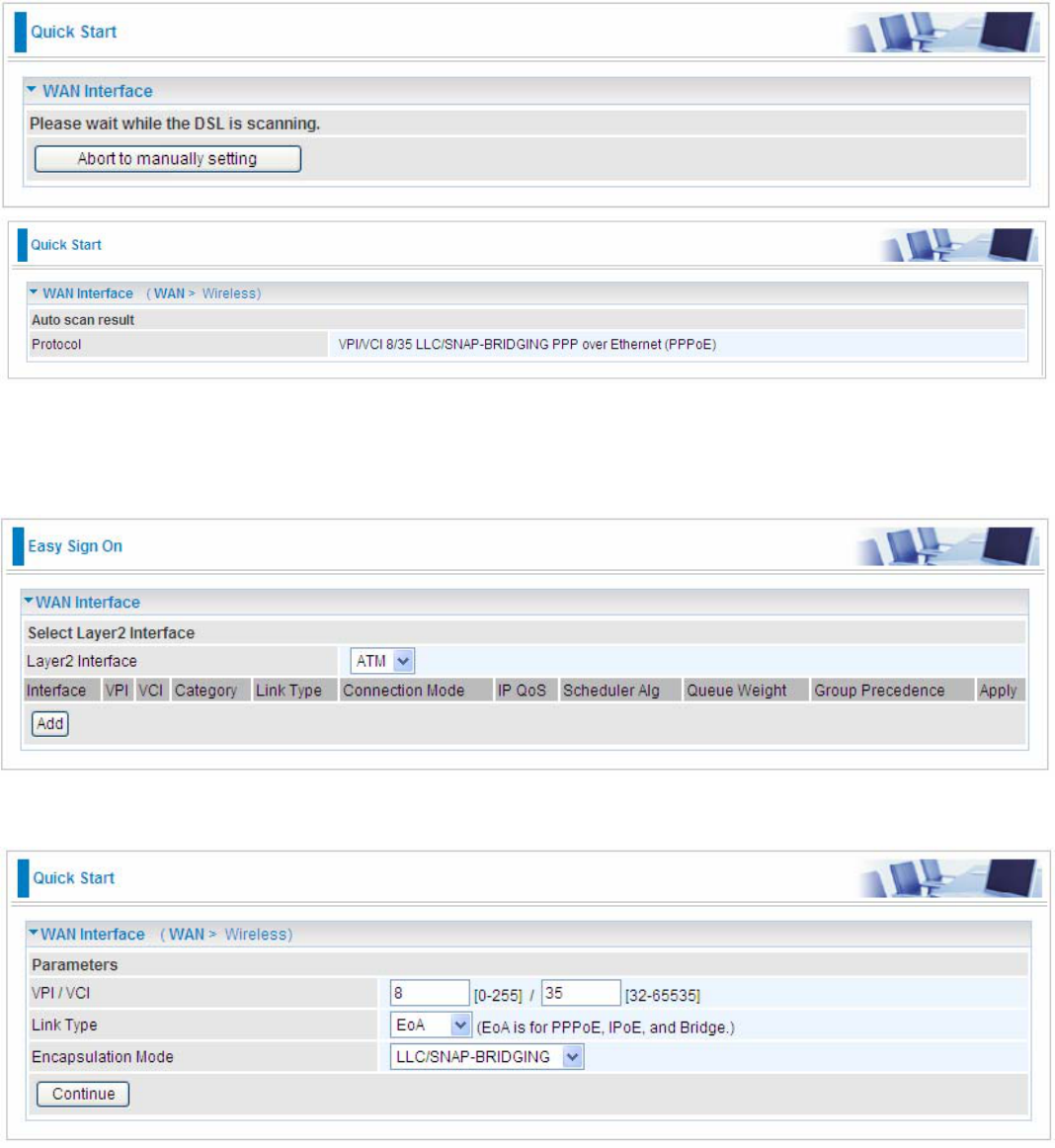
40
3. Here wait while the DSL is scanning, when the scanning is OK, the scanning result will appear,
see screen 3, and then it will quickly goes to step 6. Or you can Abort to manually setting to step 4.
Screen 3
4. Here you should select the Layer2 Interface. ATM and PTM are two kinds of transmission mode.
You can select according to your ISP. Select ATM for example. Click Add to add WAN Interface.
5. Enter the VPI/VCI from your ISP.
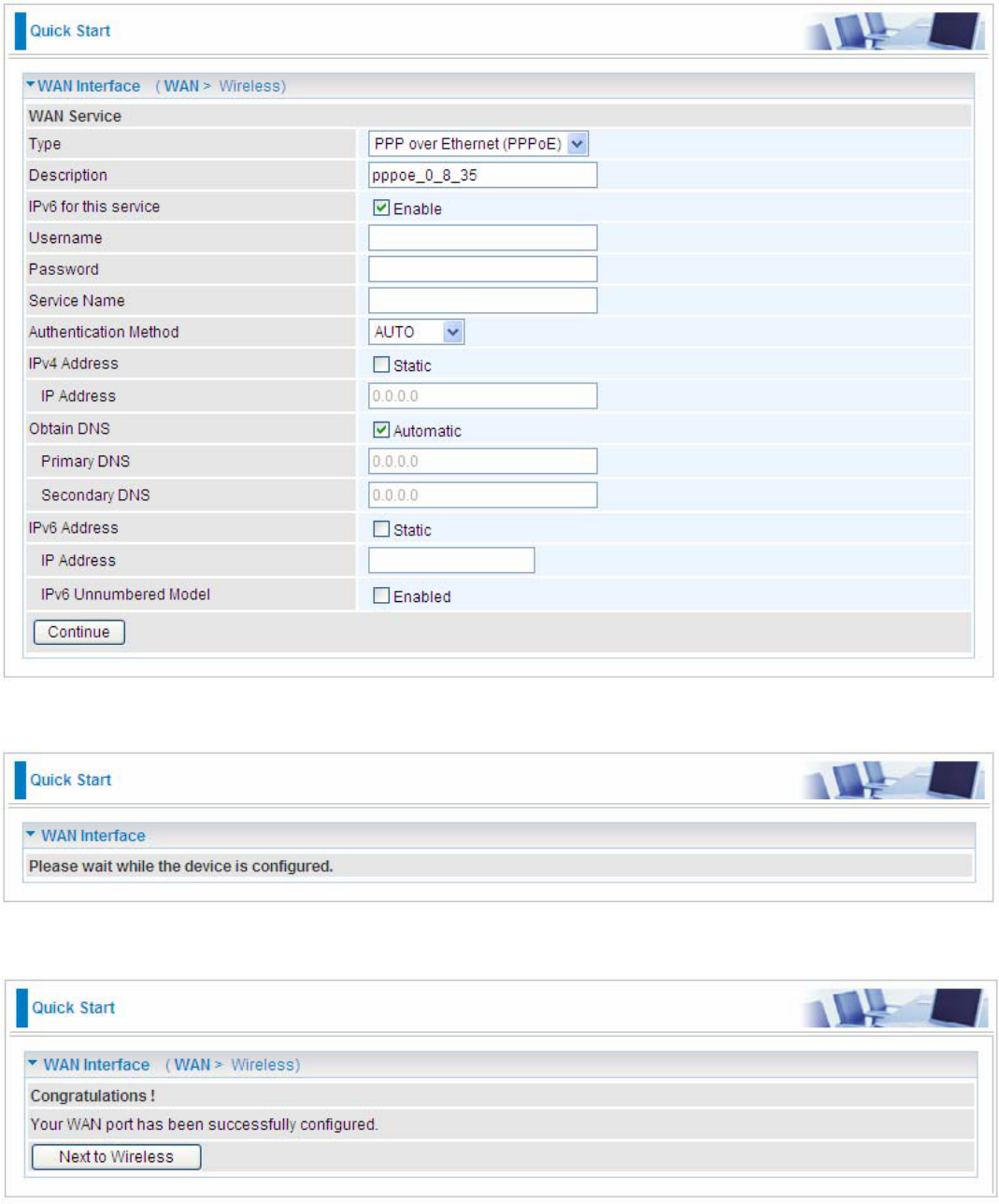
41
6. Enter the username, password from your ISP, for IP and DNS settings, also refer to your ISP.
Here IPv6 service is enabled by default.
7. Wait while the device is configured.
8. WAN port configuration is success.
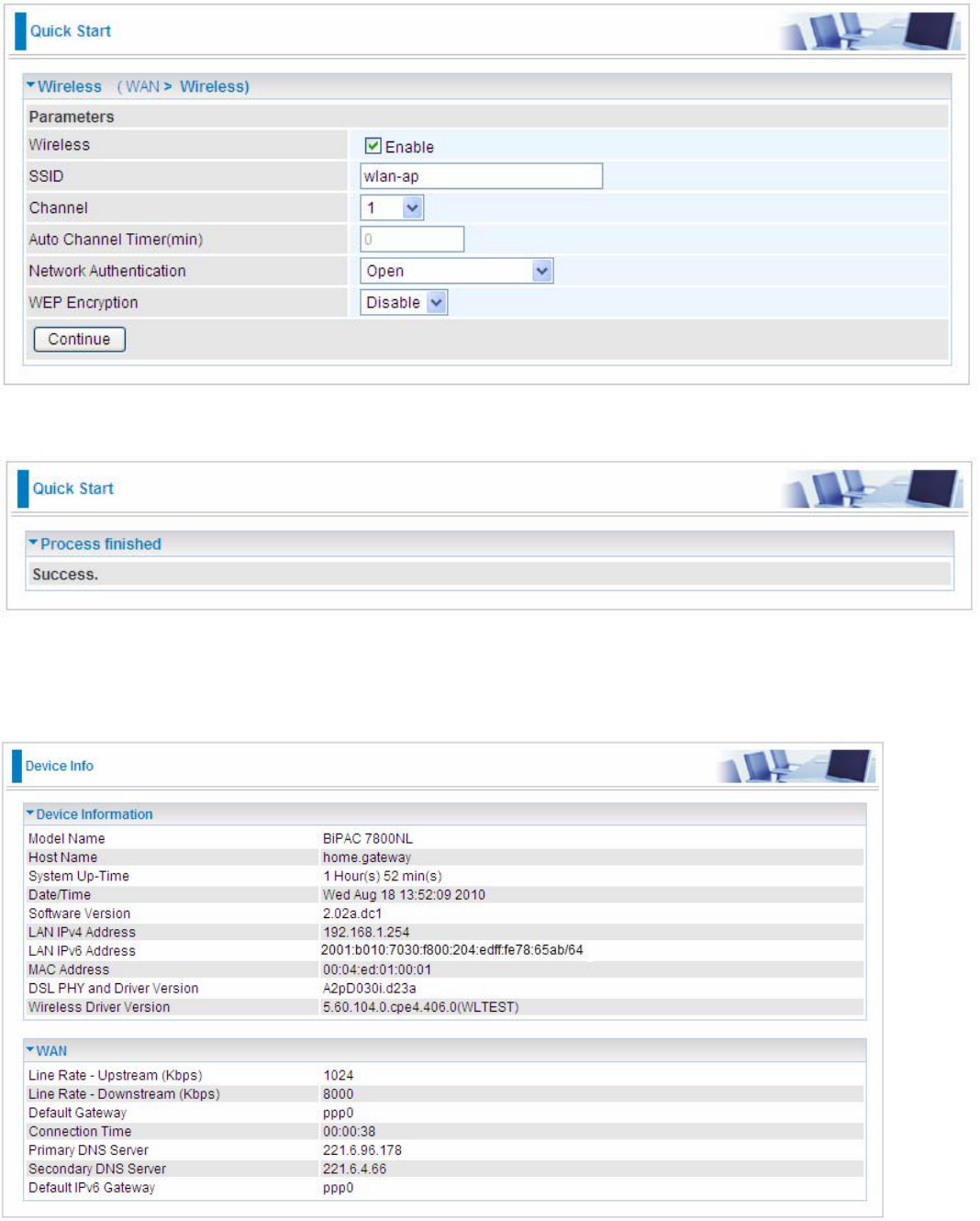
42
9. After the configuration is successful, click Next to Wireless button and you may proceed to
configure the Wireless setting. For security information, please turn to wireless>security section in
this manual for help.
10. Configuration’s success.
Then you successfully quick configured your router and can access the internet, turn to Device Info,
you will see the basic information.
For more information, turn to Advanced setup for help.
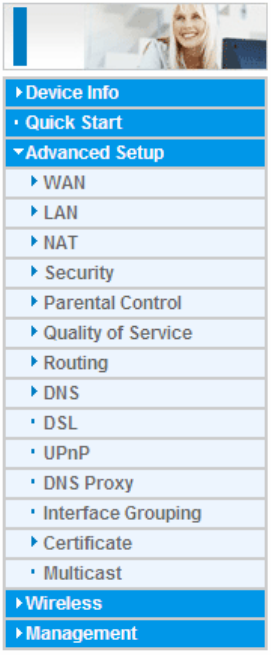
43
Advanced setup
When you click this item, the column will expand to display the sub-items that will allow you to further
configure your router.
WAN, LAN, NAT, Security, Parental Control, Quality of Service, Routing, DNS, DSL, UPnP,
DNS Proxy, Interface Grouping, Certificate and Multicast.
The function of each configuration sub-item is described in the following sections.
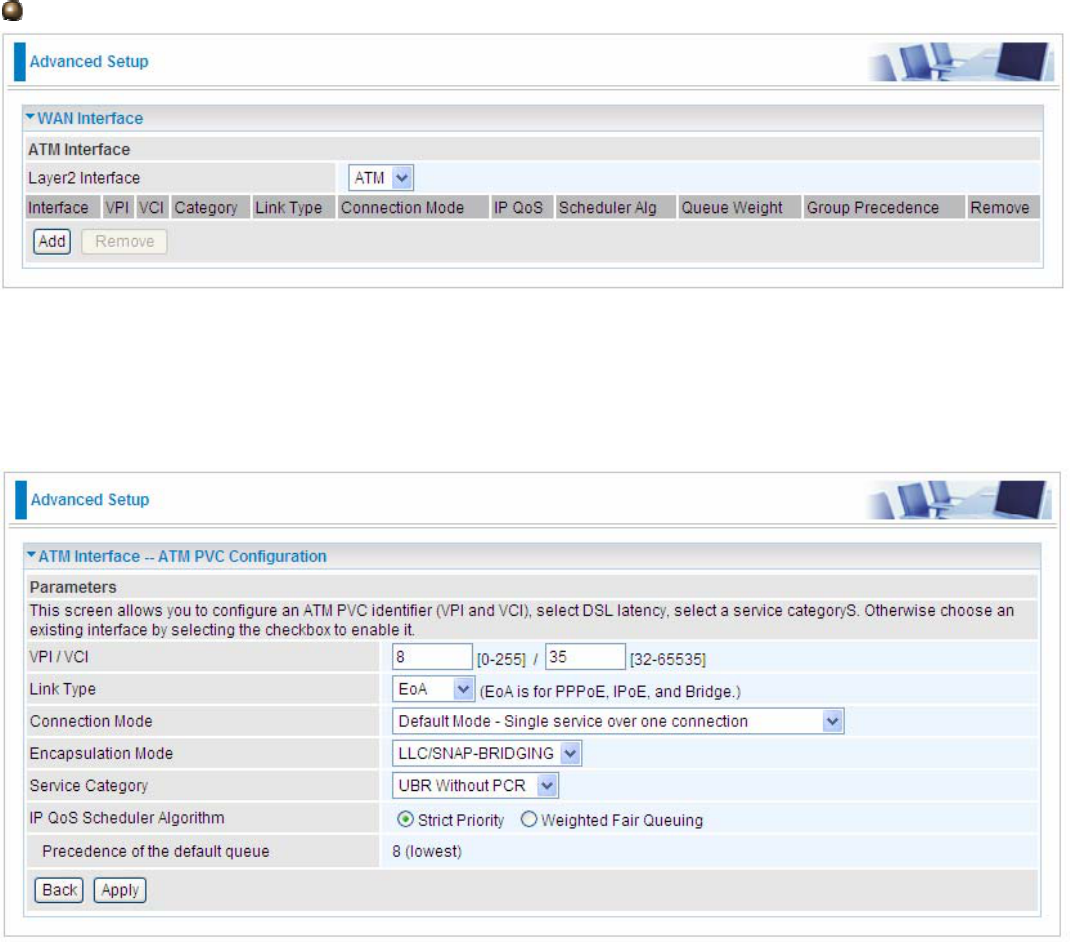
44
WAN-Wide Area Network
A WAN (Wide Area Network) is a computer network that covers a broad geographical area (eg.
Internet) that is used to connect LAN and other types of network systems. There are the items
within the WAN section: WAN Interface and WAN Service.
WAN Interface
ATM
Layer2 Interface: 2 transfer mode, ATM or PTM.
The following is the interface listing table.
Click Add to add WAN interface.
VCI/VPI: enter the VCI/VPI from your ISP.
Link Type: select the link type (protocol), EOA, PPPoA, IPoA.
Connection Mode:
L Default Mode: this mode only allows single service over one connection.
L VLAN MUX Mode: this mode allows multiple services over one PVC.
The two modes can be different in WAN service configuration. And PPPoA and IPoA do not use
Ethernet frames for data transfer so they cannot work with VLAN Mux feature. Thus, Connection
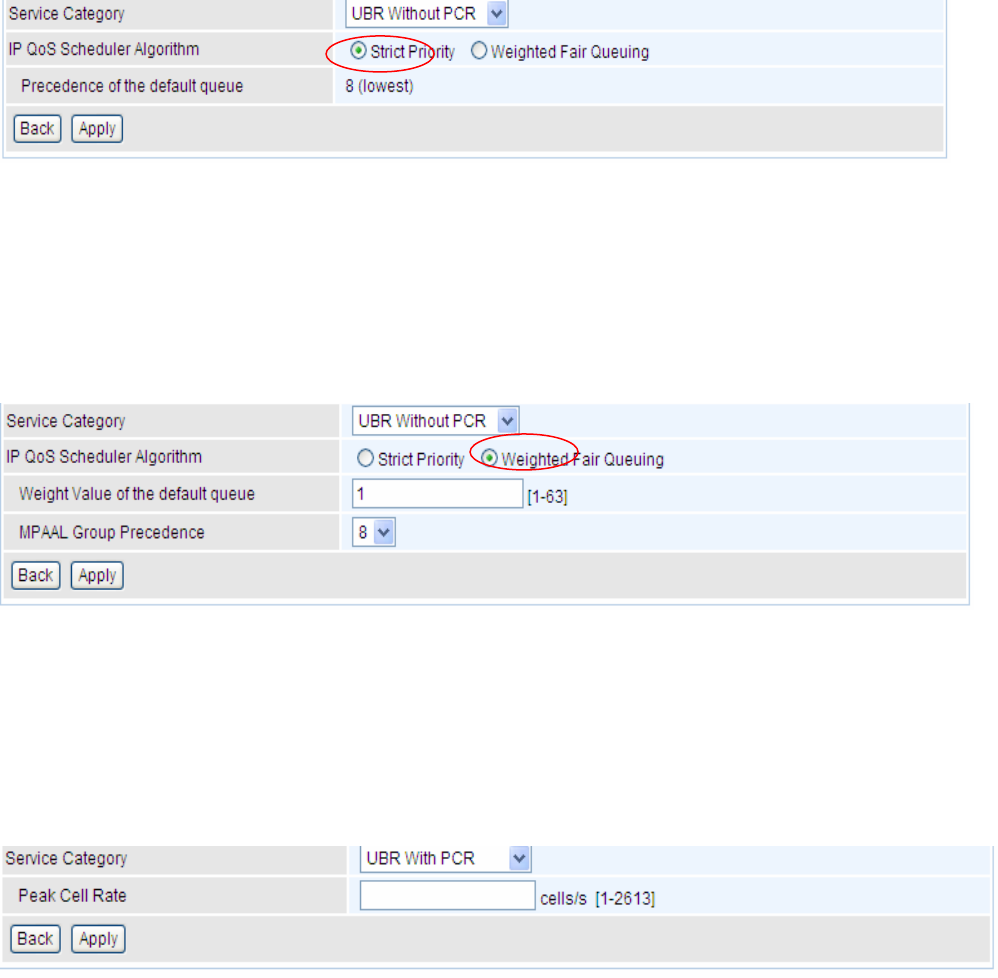
45
Mode Parameter will be hided if you select PPPoA or IPoA in Link Type.
Encapsulation Mode: select the encapsulation mode from the drop-down menu according to the
link Type.
Service Category: select the service category from the drop-down menu to determine your service
category.
L UBR without PCR: UBR(Unspecified Bit Rate), PCR(Peak cell Rate)
UBR is a kind of QoS, which doesn’t provide assurance about the cell latency, the bit loss rate etc,
it is a best-effort service.
IP QoS Schedule Algorithm: select the Schedule Algorithm, SP(Strict Priority), always sends the
packets with the highest priority, WFQ(Weighted Fair Queuing), an automatically bandwidth
adjusting method, sharing the available bandwidth when congestion happens, the bandwidth is
assigned according to the priority and the weight value. Turn to the Quality of Service > Queue
Config section for more information.
Precedence of the default queue: default 8(lowest)
Weight Value of default queue: enter the value, 1-63, the highest is 63.
MPAAL Group Precedence: select the precedence identification, 1-8, the highest is 1.
L UBR with PCR/ CBR(Constant Bit Rate)
UBR is a kind of service providing constant rate service, is idea for timely and fixed bandwidth
needed service.
Peak Cell Rate: enter Peak Cell Rate.
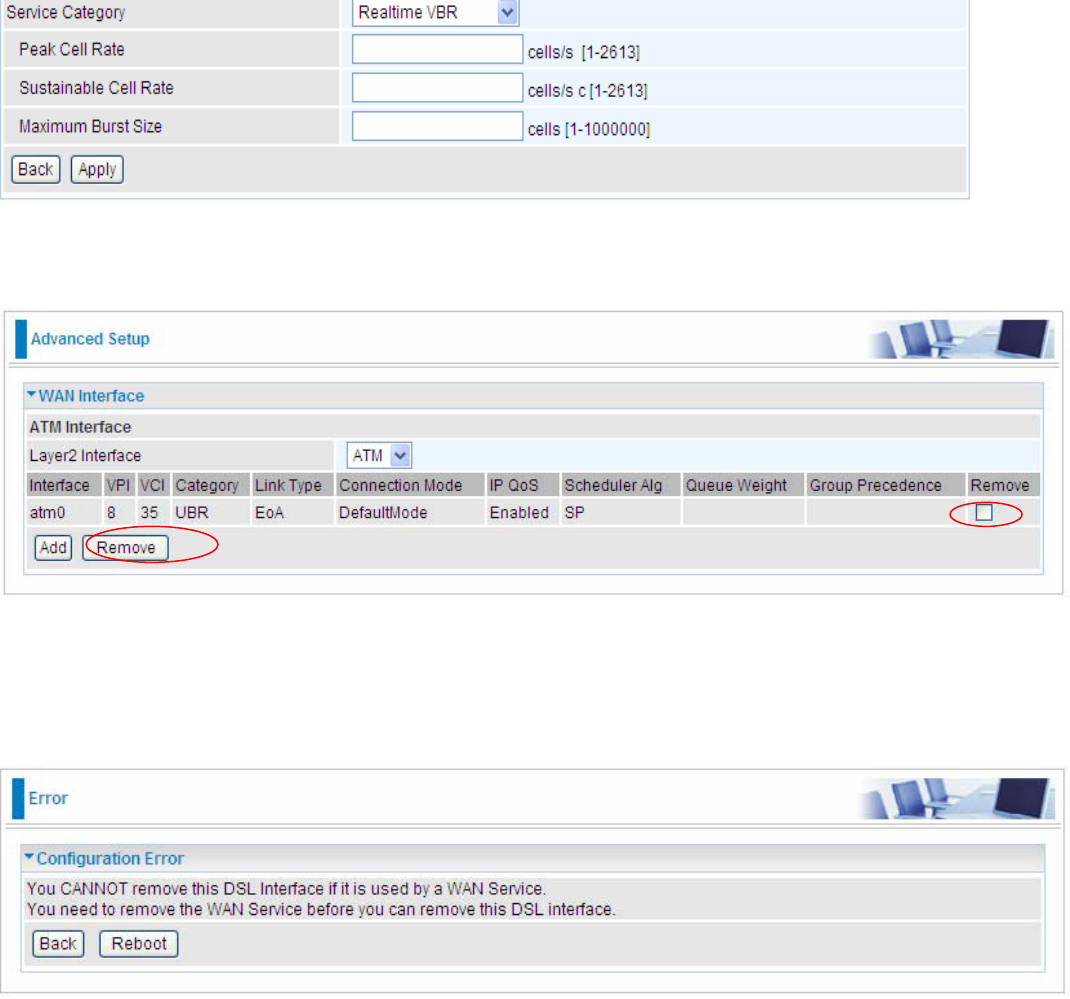
46
L None Realtime VBR/ Realtime VBR(Variable Bit Rate)
VBR is a kind of service providing some assurance about latency and bit loss rate and is often
associated with video and time sensitive service. NR-VBR allows more time delay to R-VBR.
Enter Peak Cell Rate, Sustainable Cell Rate and Maximum Burst Rate.
Click Apply to apply the WAN interface.
Check the remove checkbox, then press Remove to delete it only if this interface are not used by a
WAN Service, if it is used by a WAN service, first remove the WAN service, then turn back to remove
the interface.
Don’t feel confused, it will remind you by the following prompt window.
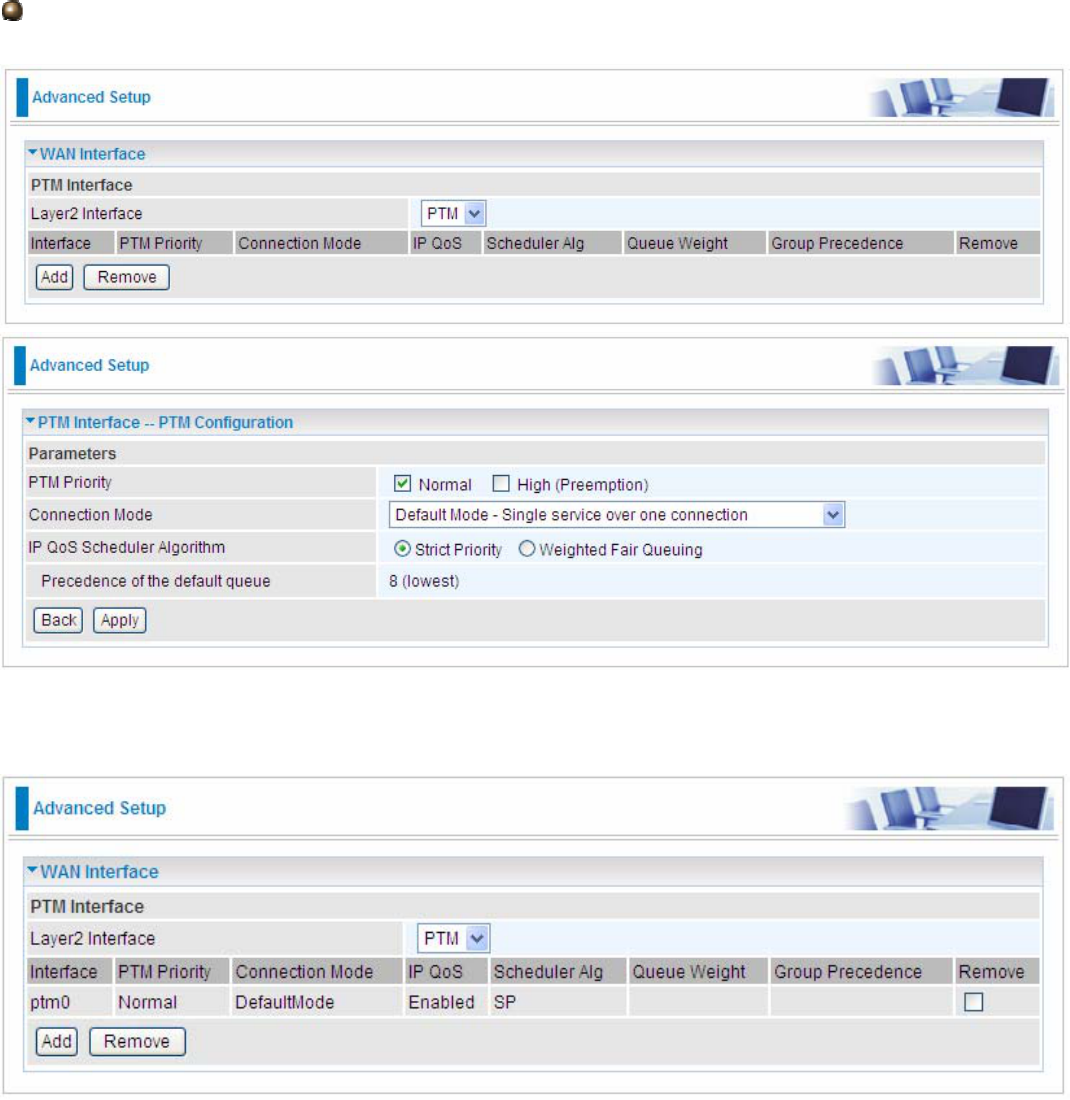
47
PTM
PTM Setting is similar to ATM.
PTM Priority: Select the PTM priority, Normal or High.
Click Apply to save your settings. The interface will be added to the PTM Interface listing table.

48
Now follow the above steps, we set two ATM WAN interfaces for future illustration, one is of
DefaultMode, and one is of VlanMuxMode.
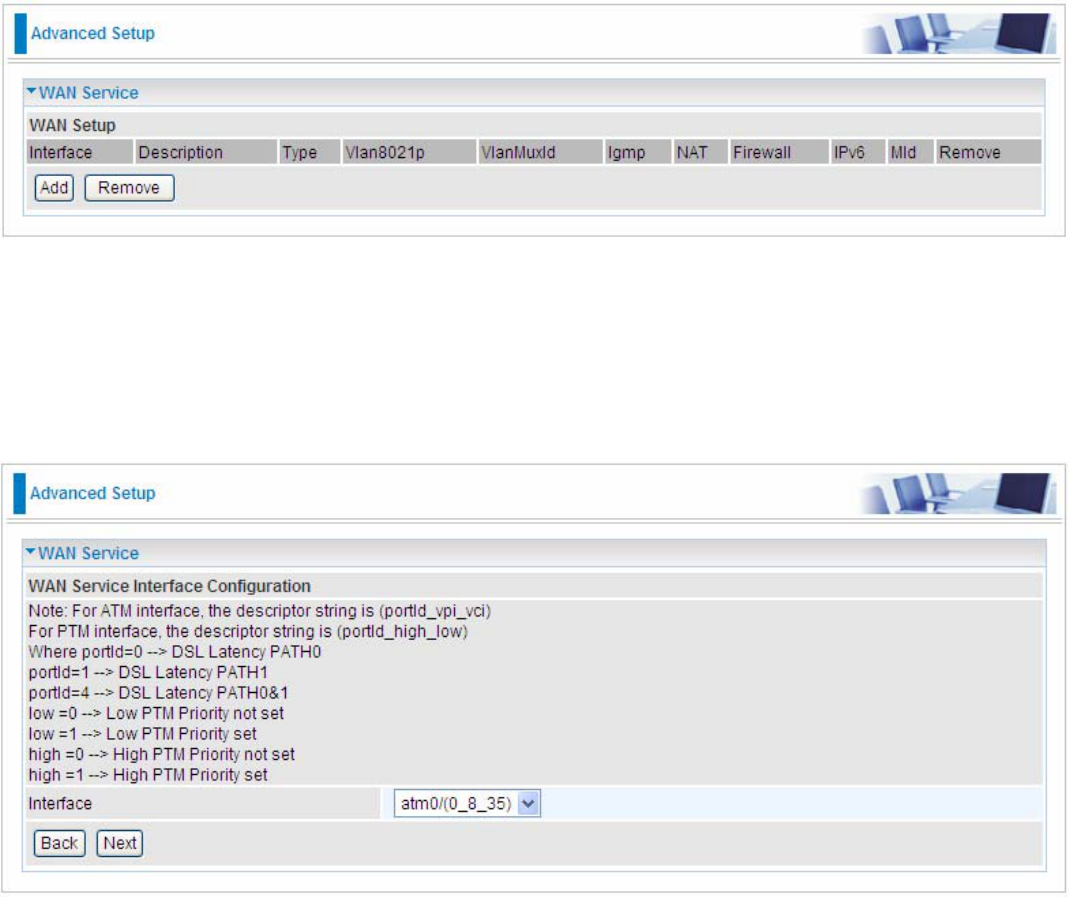
49
WAN Service
WAN Service allows you configure one or more services over one interface (connection). The
following is the WAN Service listing table. Your configured WAN service will be listed here.
Default Connection mode
Select the interface which is a Default mode connection configured in WAN Service, here for
example, in the following, atm0/(0_8_35) is a Default mode connection.
Click Add to create one WAN service.
Select the interface, the listed interfaces are the one you configured in WAN interface section. Click
Next to further configure.
51
Password: enter the password.
Service name: user-defined name.
Authentication method: select the authentication method.
Fullcone NAT: enable or disable fullcone NAT. Fullcone is a kind of NAT, in this mode, all requests
from the same internal IP address and port are mapped to the same external IP address and port.
Furthermore, any external host can send a packet to the internal host, by sending a packet to the
mapped external address.
Note: In PPPoE connection, NAT is enabled by default, you can determine whether to enable
Fullcone NAT. And while you disabled Fullcone NAT and only use NAT, the default NAT type is Port
Restricted cone NAT. Of Port-Restricted cone NAT, the restriction includes port numbers. Specifically,
an external host can send a packet, with source IP address X and source port P, to the internal host
only if the internal host had previously sent a packet to IP address X and port P
Dial on demand: enable or disable, if you want to Dial on demand, enable this function.
Inactivity timeout: available when you enable Dial on demand function. Enter the Inactivity
timeout interval.
IPv4 Address: enable or disable to assign static IPv4 address to PPPoE link.
IP Address: enter the Static IPv4 address if you enable Static IP Address.
Obtain DNS: check whether to obtain DNS address automatically.
Primary/Secondary DNS: if you uncheck Obtain DNS, then enter then primary/secondary DNS
address.
IPv6 Address: enable to assign static IPv6 address, else to obtain Ipv6 address automatically.
IP Address: enter the Static IPv6 address if you enable Static IPv6 Address.
IPv6 Unnumbered Model: Enables or disables IPv6 processing on an interface without assigning
an explicit IPv6 address to that interface.
Note: Suggest having IPv6 configured as default, this router can automatically assign address to
your PC, or you can have an advanced administrator to help.
PPPoE Debug mode: check whether to enable this function, it is used to debug PPPoE link, and the
debug message will be seen in System log.
Bridge PPPoE Frame between WAN and Local Ports: check whether to enable this function. It
allows PC in LAN to set up its own PPP link, or the PC will access internet via the PPP link in WAN
port.
IGMP Multicast Proxy: check whether to enable this function. IGMP (Internet Group Management
Protocol) Proxy intercepts the IGMP request from Clients and forwards it to the router after some
dealings.
MLD Multicast Proxy: check whether to enable this function. MLD (Multicast Listener Discovery
Protocol) Proxy intercepts the MLD request from Clients and forwards it to the router after some
dealings. Support MLDv1 and MLDv2.
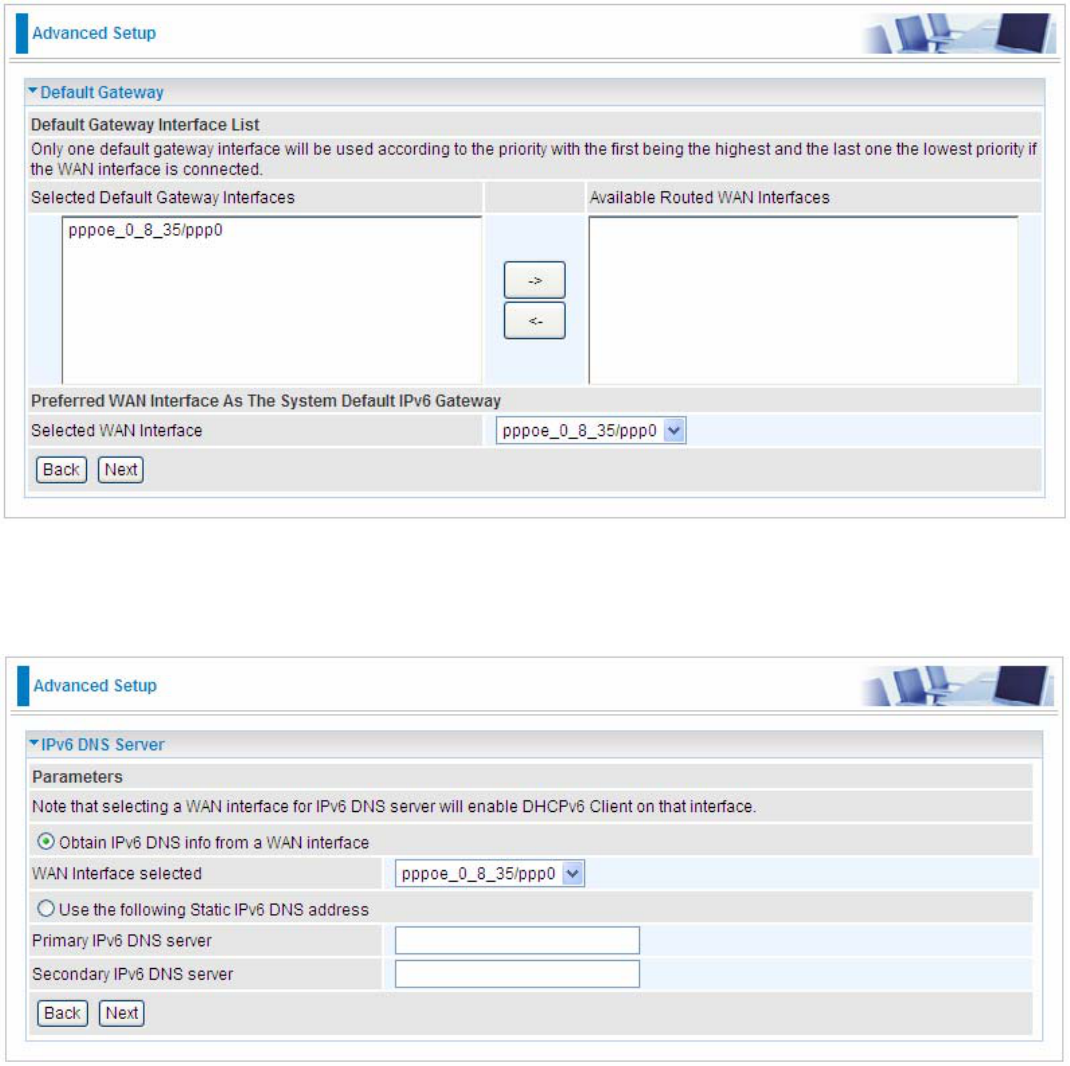
52
Click Next to go on to the Default Gateway setting.
Set the default gateway and the default IPv6 gateway.
Click Next to go on to IPv6 DNS Server setting.
IPv6 DNS Server’s operation is similar to IPv4 DNS server. There are two modes to get DNS server
address: Auto and static mode.
Obtain IPv6 DNS info from a WAN interface
WAN Interface selected: select one configured IPv6 WAN connection from the drop-down menu to
be as an IPv6 DNS.
Use the following Static IPv6 DNS address
Primary IPv6 DNS Server / Secondary IPv6 DNS Server: type the specific primary and secondary
IPv6 DNS Server address.
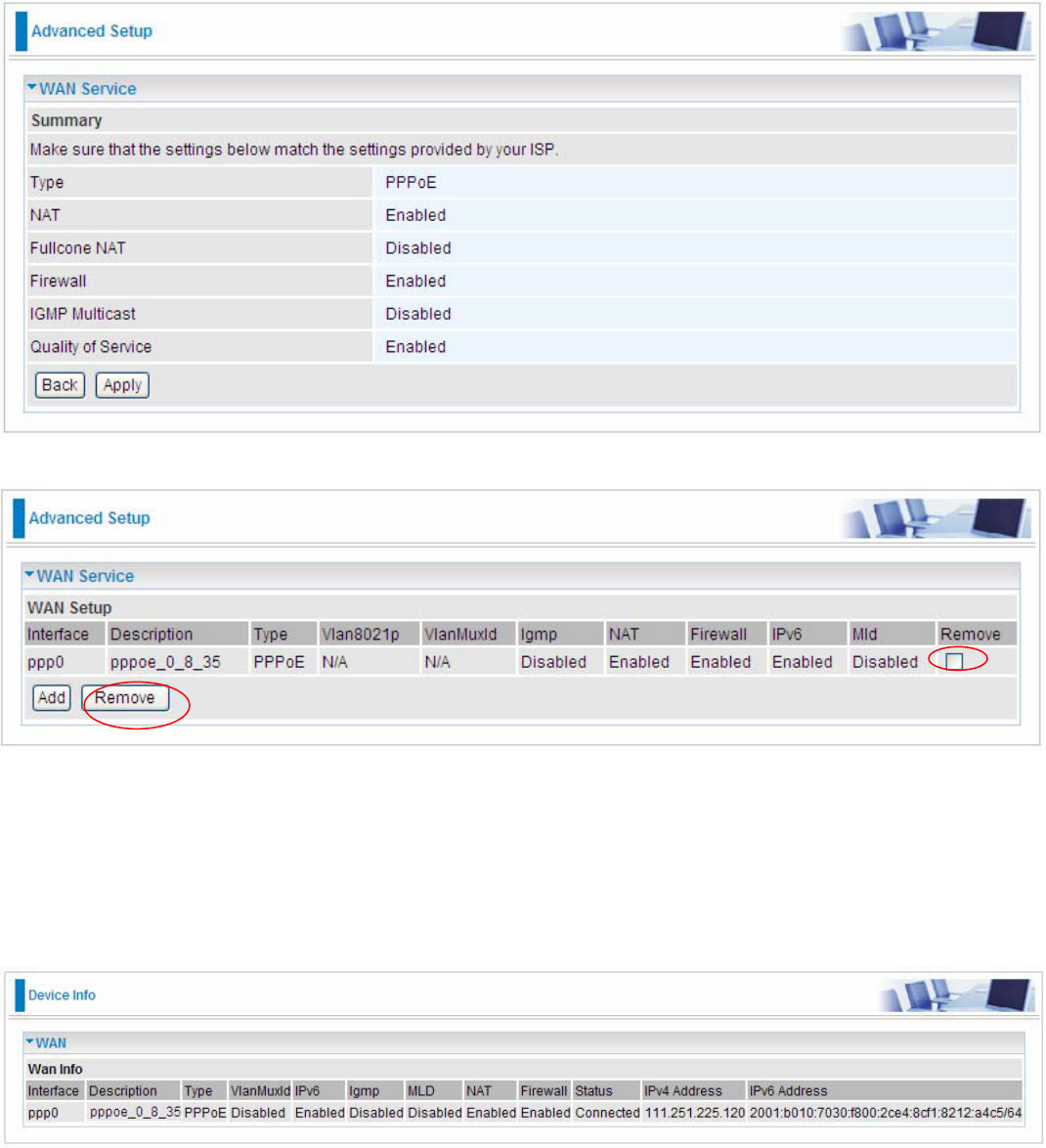
53
Click Next to check the settings.
If you confirm, click Apply to submit the settings and return to WAN service page.
If you don not need the service, select the item you want to remove, check the checkbox, then press
Remove, it will be OK.
Here the corresponding WAN interface and WAN Service have been configured, if it is OK, you can
access the internet. You can go to Device Info>WAN or Summary to view the WAN connection
information (if your ISP provides IPv6 service, then you will obtain an IPv6 address).
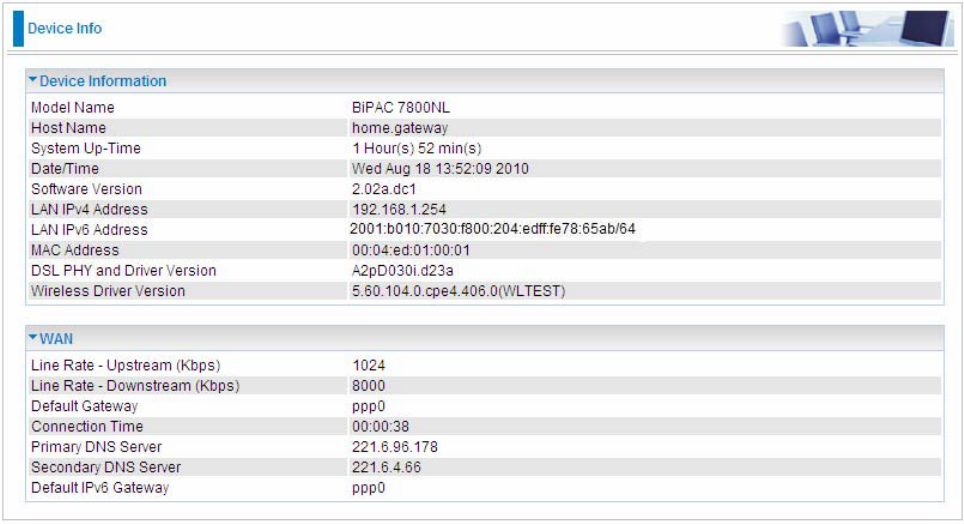
54
The device summary information
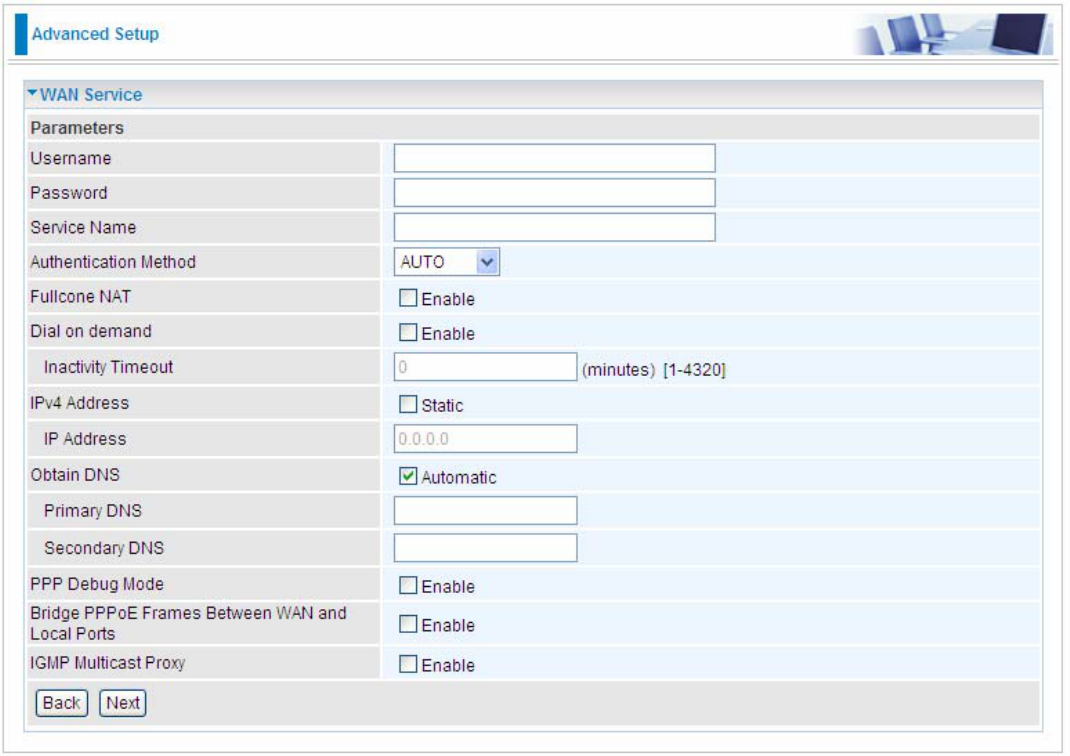
55
IPv6 disabled
Username: enter ISP account.
Password: enter the password.
Service name: user-defined name.
Authentication method: select the authentication method.
Fullcone NAT: enable or disable fullcone NAT. Fullcone is a kind of NAT, in this mode, all requests
from the same internal IP address and port are mapped to the same external IP address and port.
Furthermore, any external host can send a packet to the internal host, by sending a packet to the
mapped external address.
Note: In PPPoE connection, NAT is enabled by default, you can determine whether to enable
Fullcone NAT. And while you disabled Fullcone NAT and only use NAT, the default NAT type is Port
Restricted cone NAT. Of Port-Restricted cone NAT, the restriction includes port numbers. Specifically,
an external host can send a packet, with source IP address X and source port P, to the internal host
only if the internal host had previously sent a packet to IP address X and port P
Dial on demand: enable or disable, if you want to Dial on demand, enable this function.
Inactivity timeout: available when you enable Dial on demand function. Enter the Inactivity
timeout interval.
IPv4 Address: enable or disable to assign static IP address to PPPoE link.
IP Address: enter the Static IP address if you enable Static IP Address.
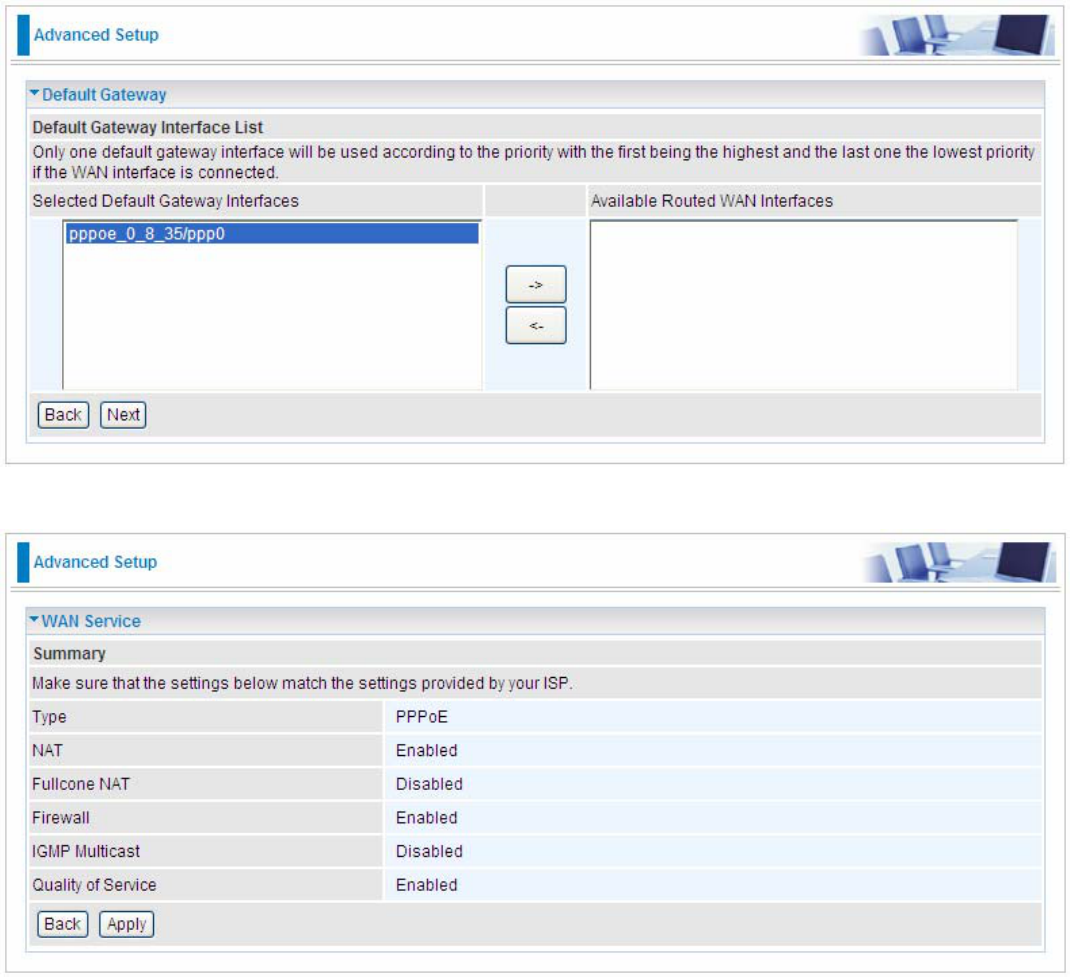
56
Obtain DNS: check whether to obtain DNS address automatically.
Primary/Secondary DNS: if you uncheck Obtain DNS, then enter then primary/secondary DNS
address.
PPPoE Debug mode: check whether to enable this function, it is used to debug PPPoE link, and the
debug message will be seen in System log.
Bridge PPPoE Frame between WAN and Local Ports: check whether to enable this function. It
allows PC in LAN to set up its own PPP link, or the PC will access internet via the PPP link in WAN
port.
IGMP Multicast Proxy: check whether to enable this function. IGMP (Internet Group Management
Protocol) Proxy intercept the IGMP request from Clients and forward it to the router after some
dealings.
Click Next to go on to the Default Gateway setting.
Click Next to go on. Then you can view the information about your settings.
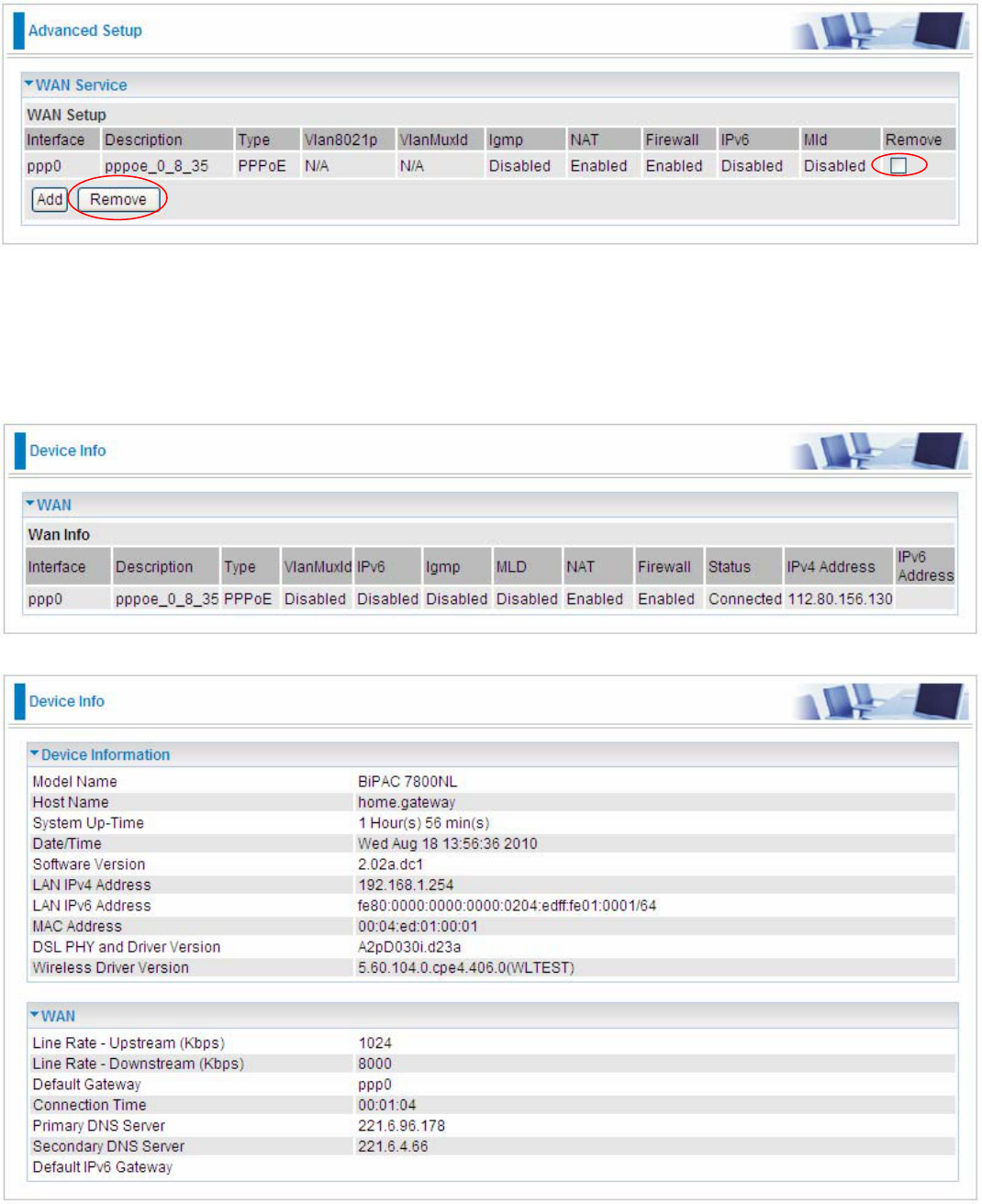
57
If you confirm about the above settings, click Apply to apply your settings. Then the service will be
listed as follows.
If you don not need the service, select the item you want to remove, check the checkbox, then press
Remove, it will be OK.
Here the corresponding WAN interface and WAN Service have been configured, if it is OK, you can
access the internet. You can go to Device Info>WAN or Summary to view the WAN connection
information.
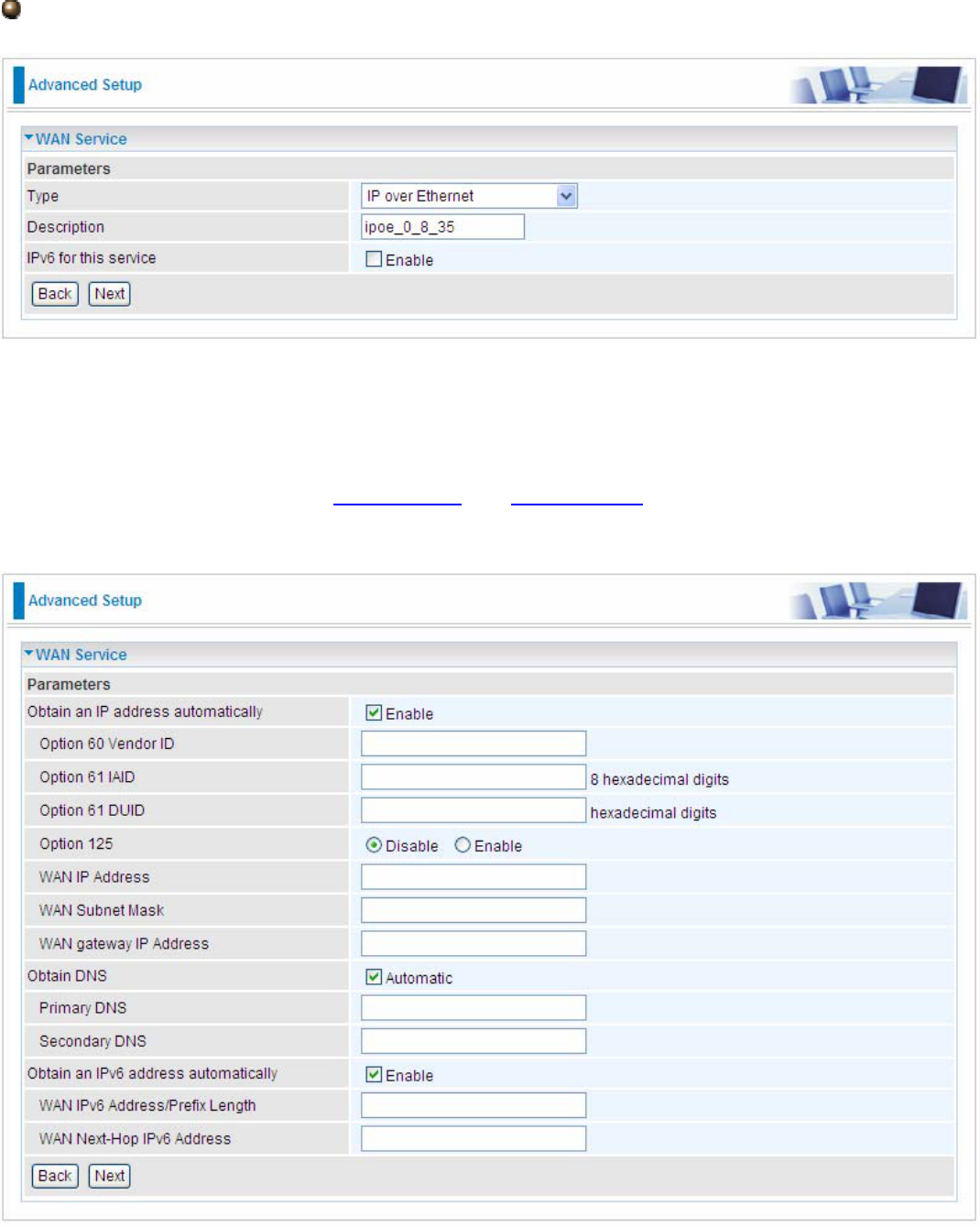
58
IP over Ethernet
Type: Select IP over Ethernet.
Description: You are allowed to enter the user defined name for this service.
IPv6 for this service: check whether to enable IPv6 feature.
Click Next to go to next step. See IPv6 enabled and IPv6 disabled .
IPv6 enabled
Here two modes are supported for users to deal with the IP and DNS. You can select obtain
automatically or manually input the information according to your ISP.
Obtain an IP address automatically: check whether to enable this function.
Option 60 Vendor ID: Enter the associated information by your ISP. This option is used by DHCP
clients to optionally identify the vendor type and configuration of a DHCP client. The information is a
string of n octets, interpreted by servers. Vendors may choose to define specific vendor class

59
identifiers to convey particular configuration or other identification information about a client.
Option 61 IAID: Enter the associated information provided by your ISP. You should input 8
hexadecimal numbers.
Option 61 DUID: Enter the associated information provided by your ISP. You should input
hexadecimal number(s).
Option 125: Option 125 is a complementary standard of DHCP protocol, it is used to encapsulate
option 125 message into DHCP offer packet before forward it to clients. After the clients receive the
packet, it check the option 125 field in the packet with the prestored message, if it is matched, then
the client accepts this offer, otherwise it will be abandoned. Check Enable or Disable this function.
Default setting is Disable.
WAN IP Address: Enter your IPv4 address to the device provided by your ISP.
WAN Subnet Mask: Enter your submask to the device provided by your ISP.
WAN gateway IP Address: Enter your gateway IP address to the device provided by your ISP.
Obtain DNS: check whether to enable obtain DNS function.
Primary/Secondary DNS: enter the primay/secondary DNS address when you uncheck Obtain
DNS checkbox.
Obtain an IPv6 address automatically: check whether to enable or disable this feature.
WAN IPv6 Address/Prefix Length: Enter the WAN IPv6 Address/Prefix Length from your ISP.
WAN Next-Hop IPv6 Address: Enter the WAN Next-Hop IPv6 Address from your ISP.
Note: If you don’t know well about the DHCP Option, you can leave it empty or leave it as default.
Click Next to go to next step.
NAT: The NAT (Network Address Translation) feature allows multiple users to access the Internet
through a single IP account by sharing the single IP address. If users on your LAN have their own
public IP addresses to access the Internet, NAT function can be disabled. When enabled, a Fullcone
NAT parameter will appear, you can determine whether to enable Fullcone NAT. While only NAT
enabled, the default NAT type Port-Restricted cone NAT will be used. For detail, please turn to page
47 for help.
Firewall: Check/uncheck this item to enable/disable firewall function.
IGMP Multicast: IGMP (Internet Group Membership Protocol) is a protocol used by IP hosts to
report their multicast group memberships to any immediately neighboring multicast routers. Check
this item to enable IGMP multicast on that WAN interface for multicast forwarding.
MLD Multicast Proxy: check whether to enable this function. MLD (Multicast Listener Discovery
Protocol) Proxy intercept the MLD request from Clients and forward it to the router after some
dealings. Support MLDv1 and MLDv2.
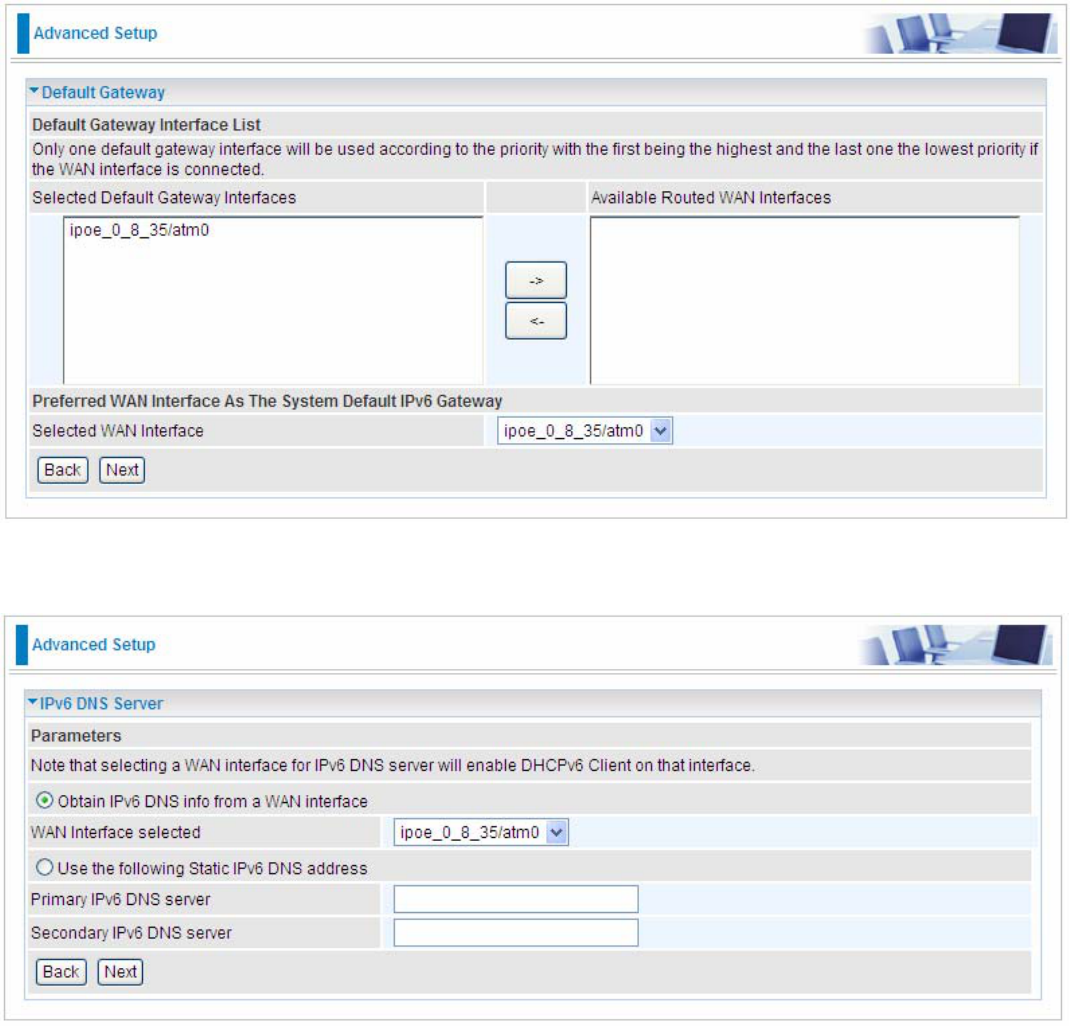
60
Click Next to go to set default gateway.
Set the default gateway and the default IPv6 gateway.
Click Next to go on to IPv6 DNS server setting.
IPv6 DNS Server’s operation is similar to IPv4 DNS server. There are two modes to get DNS server
address: Auto and static mode.
Obtain IPv6 DNS info from a WAN interface
WAN Interface selected: select one configured IPv6 WAN connection from the drop-down menu to
be as an IPv6 DNS.
Use the following Static IPv6 DNS address
Primary IPv6 DNS Server / Secondary IPv6 DNS Server: type the specific primary and secondary
IPv6 DNS Server address.
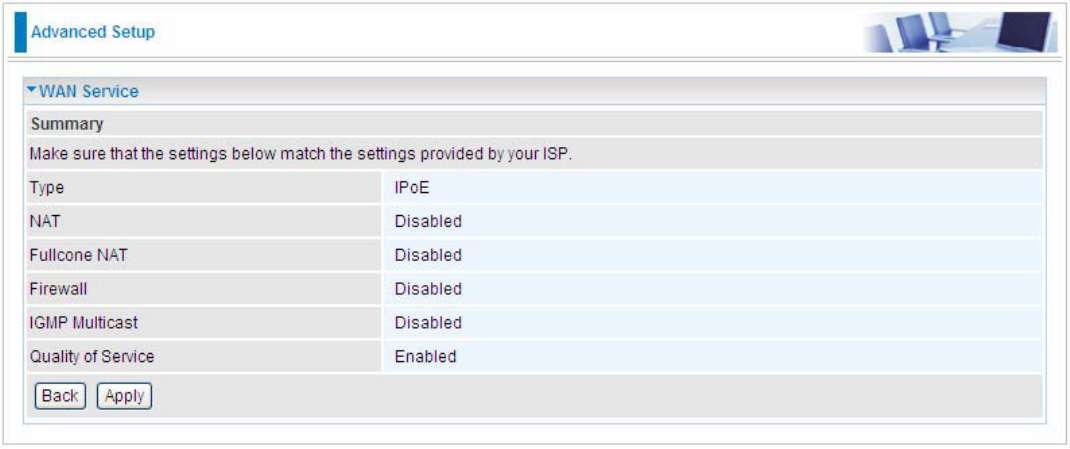
61
Click Next to check the settings.
If you confirm, click Apply to submit the settings.
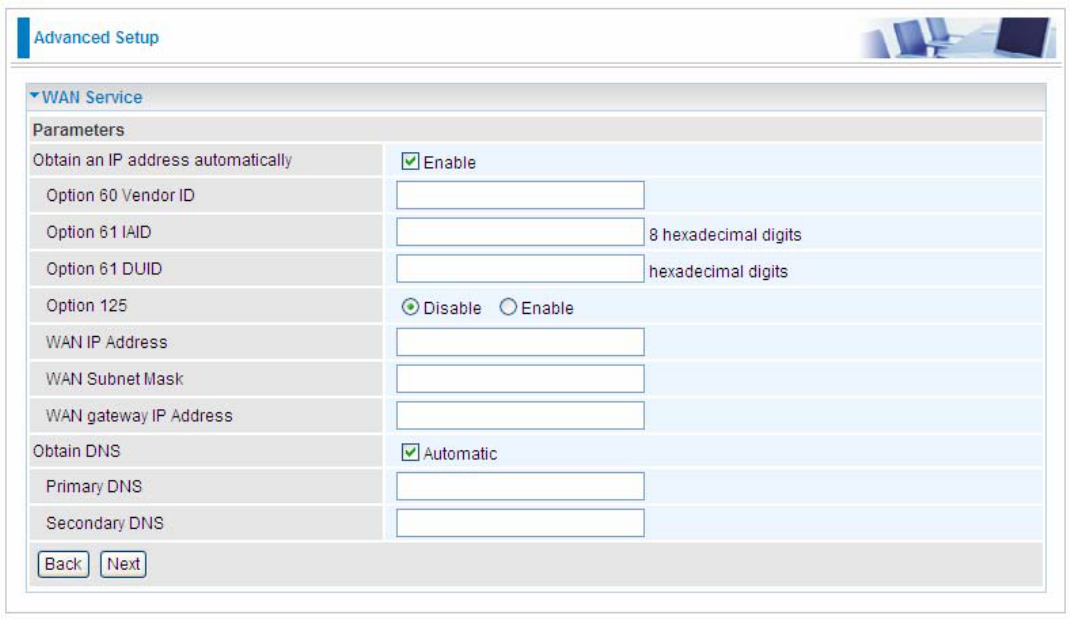
62
IPv6 disabled
Here two modes are supported for users to deal with the IP and DNS. You can select obtain
automatically or manually input the information according to your ISP.
Obtain an IP address automatically: check whether to enable this function.
Option 60 Vendor ID: Enter the associated information by your ISP. This option is used by DHCP
clients to optionally identify the vendor type and configuration of a DHCP client. The information is a
string of n octets, interpreted by servers. Vendors may choose to define specific vendor class
identifiers to convey particular configuration or other identification information about a client.
Option 61 IAID: Enter the associated information provided by your ISP. You should input 8
hexadecimal numbers.
Option 61 DUID: Enter the associated information provided by your ISP. You should input
hexadecimal number(s).
Option 125: Option 125 is a complementary standard of DHCP protocol, it is used to encapsulate
option 125 message into DHCP offer packet before forward it to clients. After the clients receive the
packet, it check the option 125 field in the packet with the prestored message, if it is matched, then
the client accepts this offer, otherwise it will be abandoned. Check Enable or Disable this function.
Default setting is Disable.
WAN IP Address: Enter your IP address to the device provided by your ISP. If Fixed IP Address is
selected in the IPv4 Protocol field, default value 0.0.0.0 will display in this field.
WAN Subnet Mask: Enter your submask to the device provided by your ISP.
WAN gateway IP Address: Enter your gateway IP address to the device provided by your ISP.
Obtain DNS: check whether to enable obtain DNS function.
Primary/Secondary DNS: enter the primay/secondary DNS address when you uncheck Obtain
DNS checkbox.
Note: If you don’t know well about the DHCP Option, you can leave it empty or leave it as default.
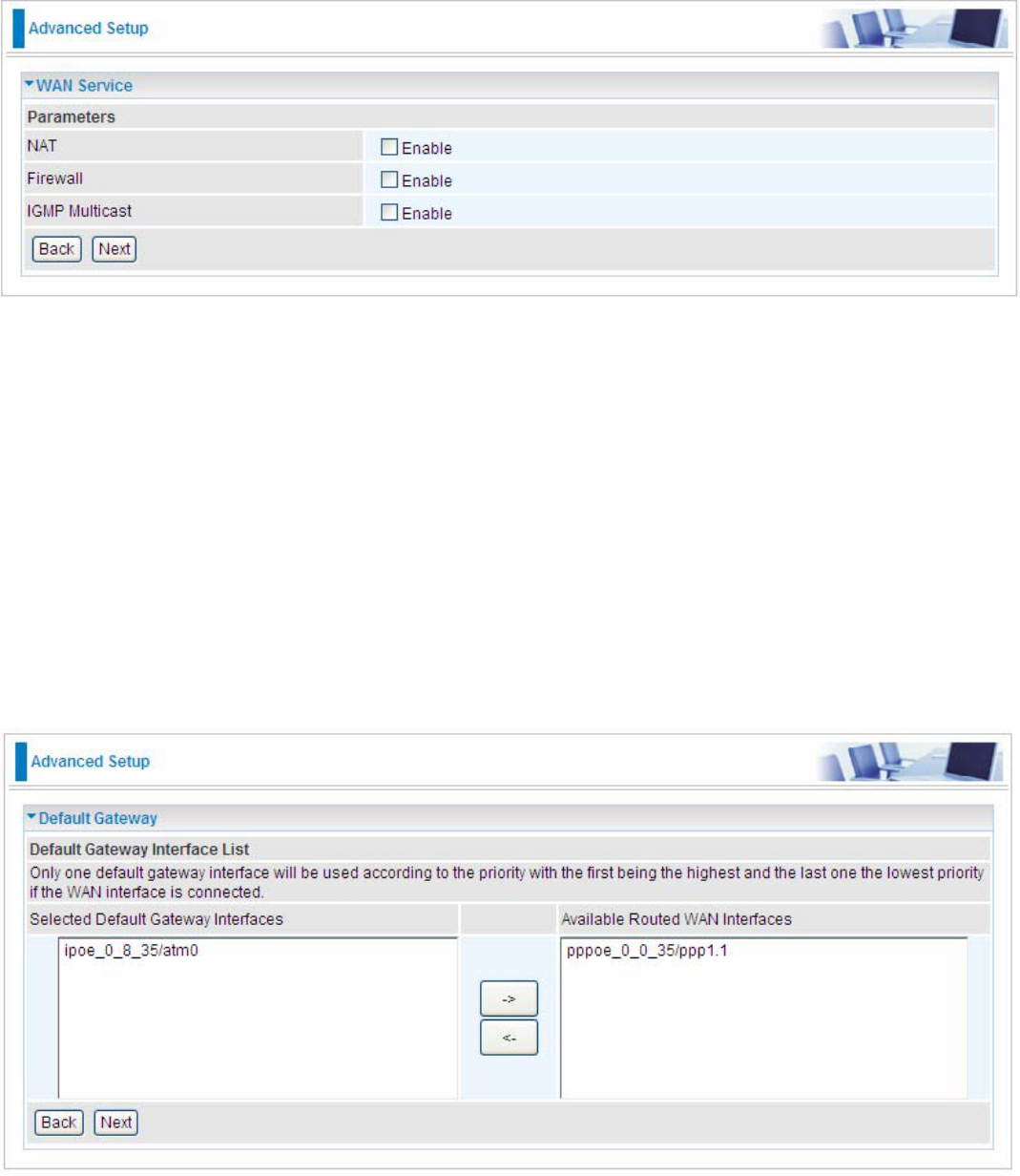
63
Click Next to go to next step.
NAT: The NAT (Network Address Translation) feature allows multiple users to access the Internet
through a single IP account by sharing the single IP address. If users on your LAN have their own
public IP addresses to access the Internet, NAT function can be disabled. When enabled, a Fullcone
NAT parameter will appear, you can determine whether to enable Fullcone NAT. While only NAT
enabled, the default NAT type Port-Restricted cone NAT will be used. For detail, please turn to page
47 for help.
Firewall: Check/uncheck this item to enable/disable firewall function.
IGMP Multicast: IGMP (Internet Group Membership Protocol) is a protocol used by IP hosts to
report their multicast group memberships to any immediately neighboring multicast routers. Check
this item to enable IGMP multicast on that WAN interface for multicast forwarding.
Click Next to go to set default gateway.
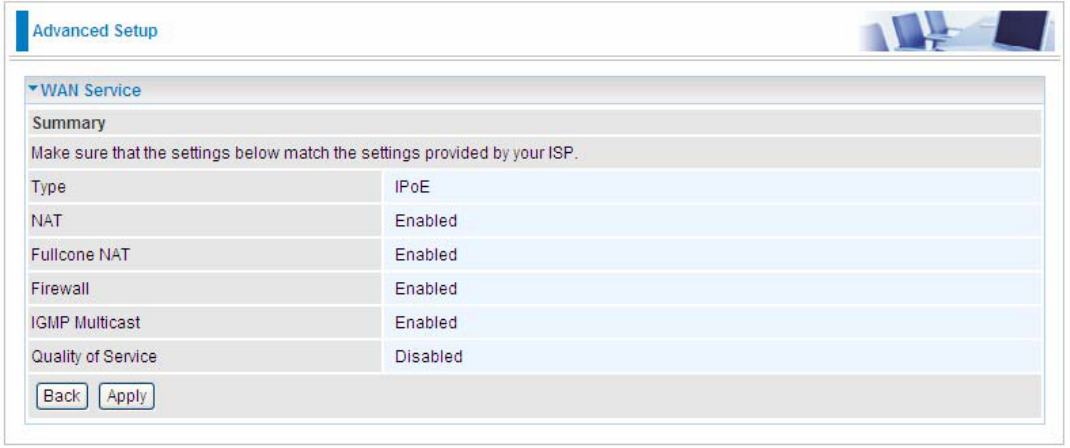
64
Click Next to go on to check the settings.
Click Apply to apply your settings.
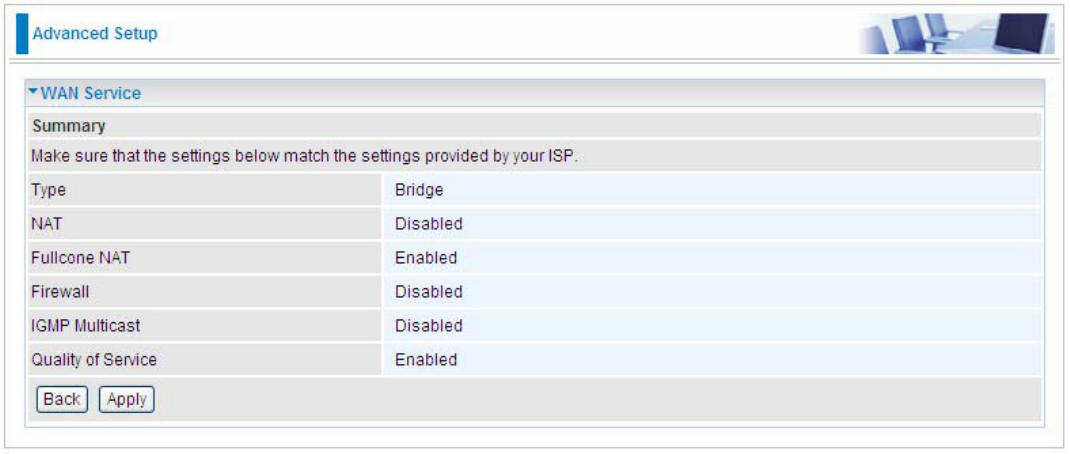
66
IPv6 disabled
Click Apply to apply your settings.
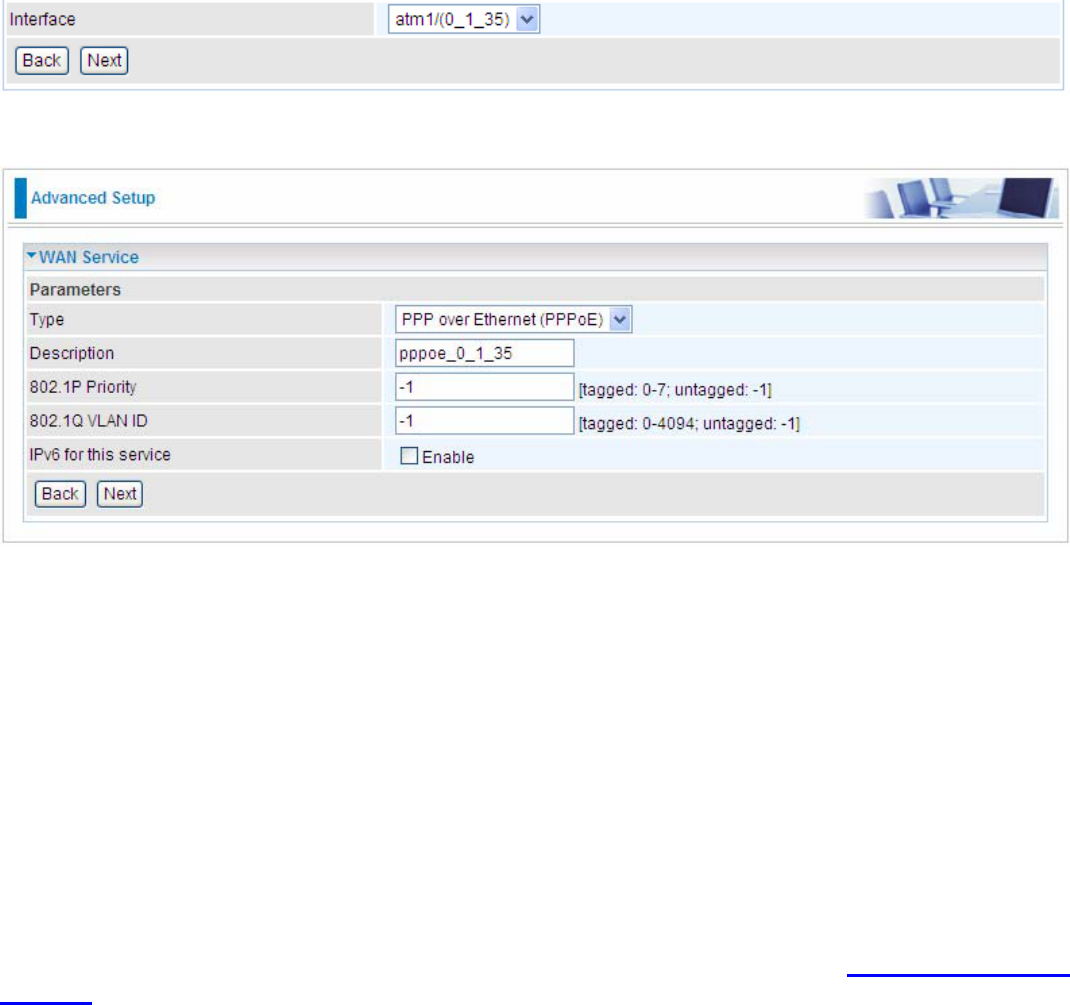
67
VLAN MUX Connection Mode
It is similar to Default Connection in configuration. Select the interface which is a VLAN MUX mode
connection configured in WAN Service, here for example, in the following, atm1/(0_1_35) is a VLAN
MUX mode connection.
select interface(VLAN MUX mode).
Click Next to go on to next step.
Type: select the protocol, PPPoE, IP over Internet, Bridge.
Description: user-defined description.
802.1P Priority: It indicates the frame priority level from 0 (lowest) to 7 (highest), which can be used
to prioritize different classes of traffic (voice, video, data, etc). Enter the priority identification,
tagged:0-7, untagged:-1.
802.1Q VLAN ID: It is a parameter to specify the VLAN which the frame belongs. Enter the VLAN ID
identification, tagged: 0-4094, untagged:-1.
You can leave 802.1P Priority and 802.1Q VLAN ID as default setting,-1, means untagged, in this
mode, the vlan tag header will not be contained, but if you want to allow one service for the specific
vlan, here you should set the two parameters, the vlan tag header will be contained.
IPv6 for this service: check whether to enable IPv6 service.
The following steps are similar to Default Connection settings, for help turn to Default Connection
settings.
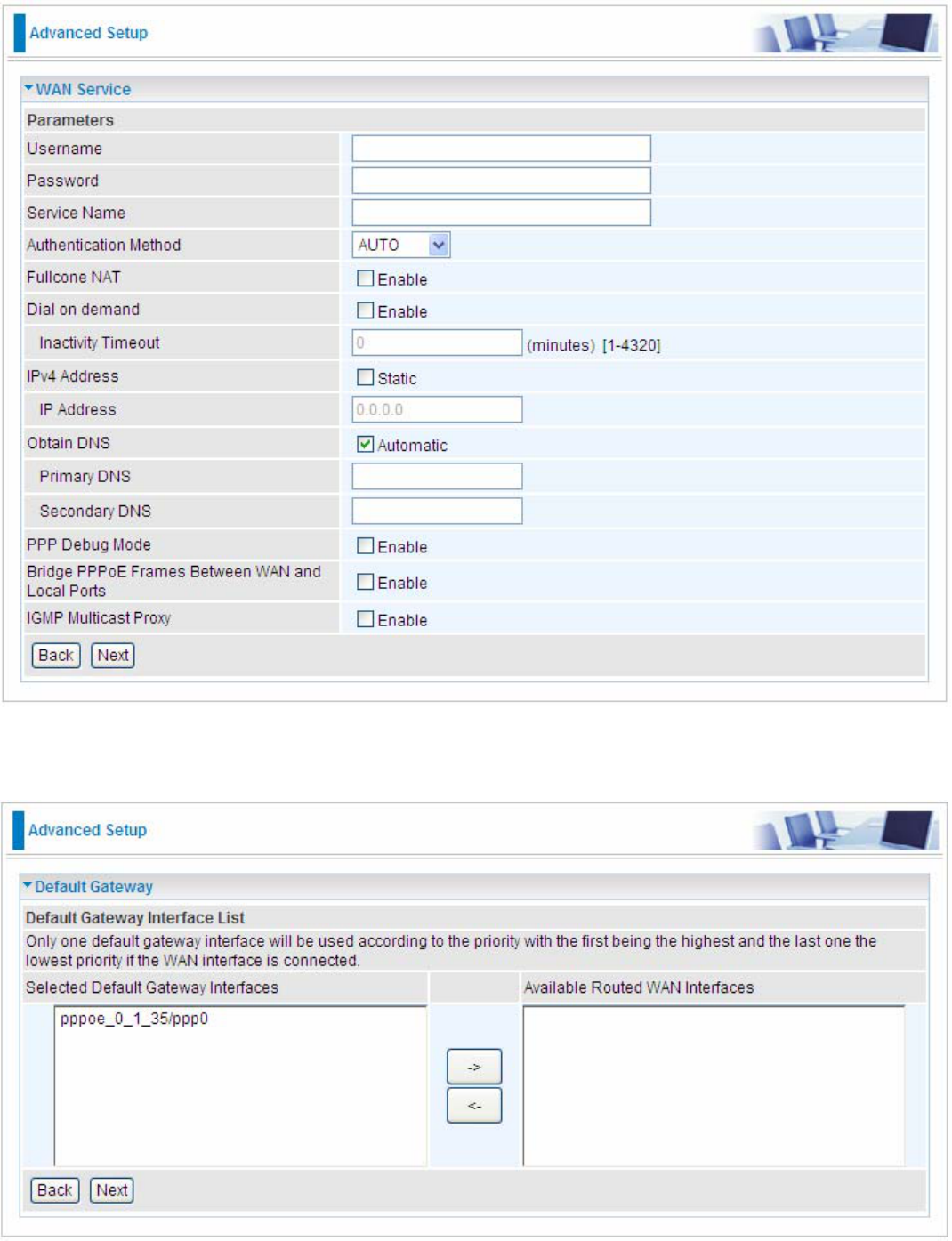
68
Take an example with IPv6 disabled, let’s look at a scenario in which 1 PPPoE and 1 Bridge service
needed by user.
In the above page, click Next to set WAN service parameters.
Click Next to set the default gateway of this connection.
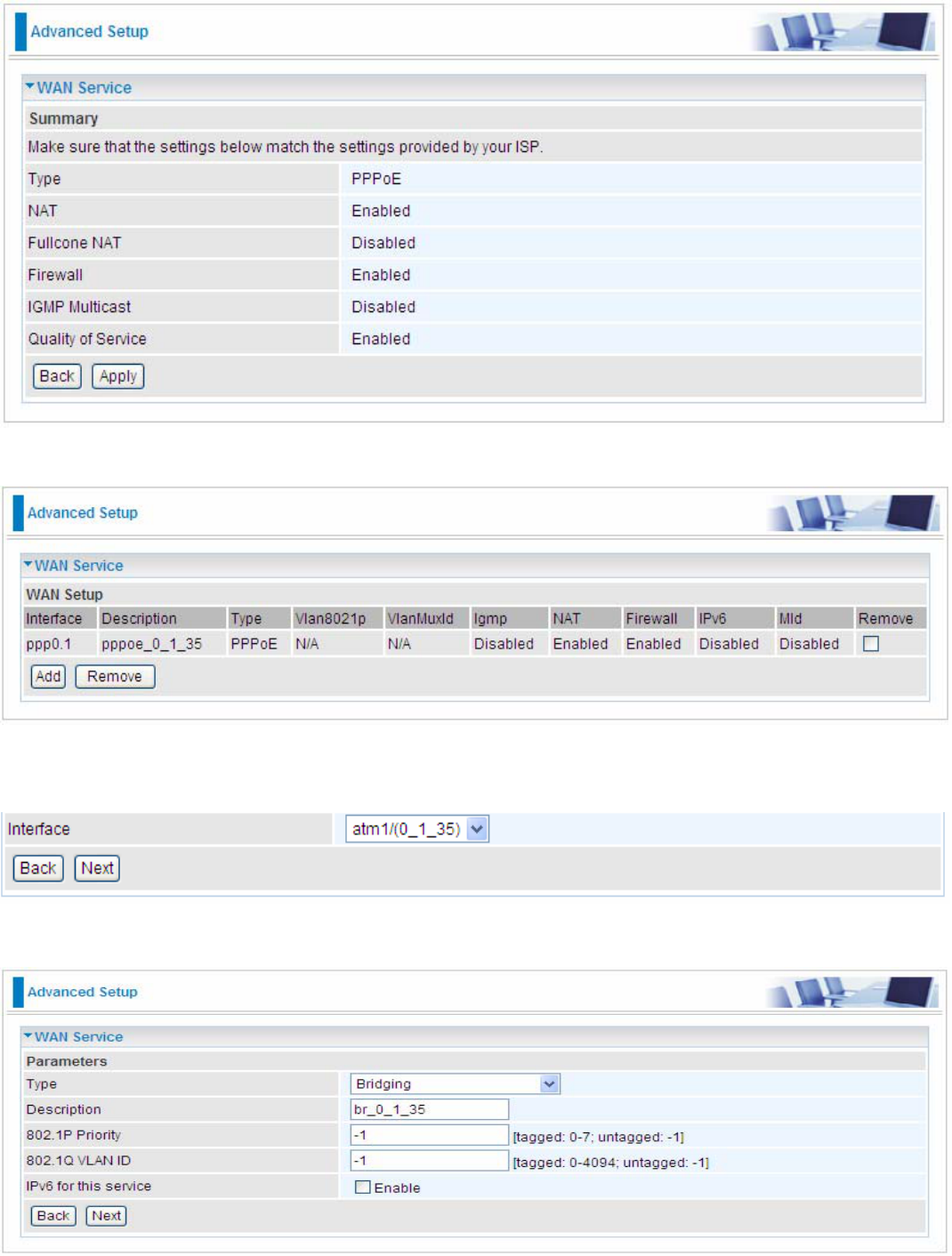
69
Click Next to view the information you have set to the connection, then click Apply to save your
settings.
Then you can see the PPPoE connection is listed below. Here it is just one service over
atm1/(0_1_35).
Then we can again set a Bridging connection over atm1/(0_1_35) interface. Click Add in the above
page, the atm1/(0_1_35) also is listed for selection to add services.
Continue clicking Next to select Bridging connection type.
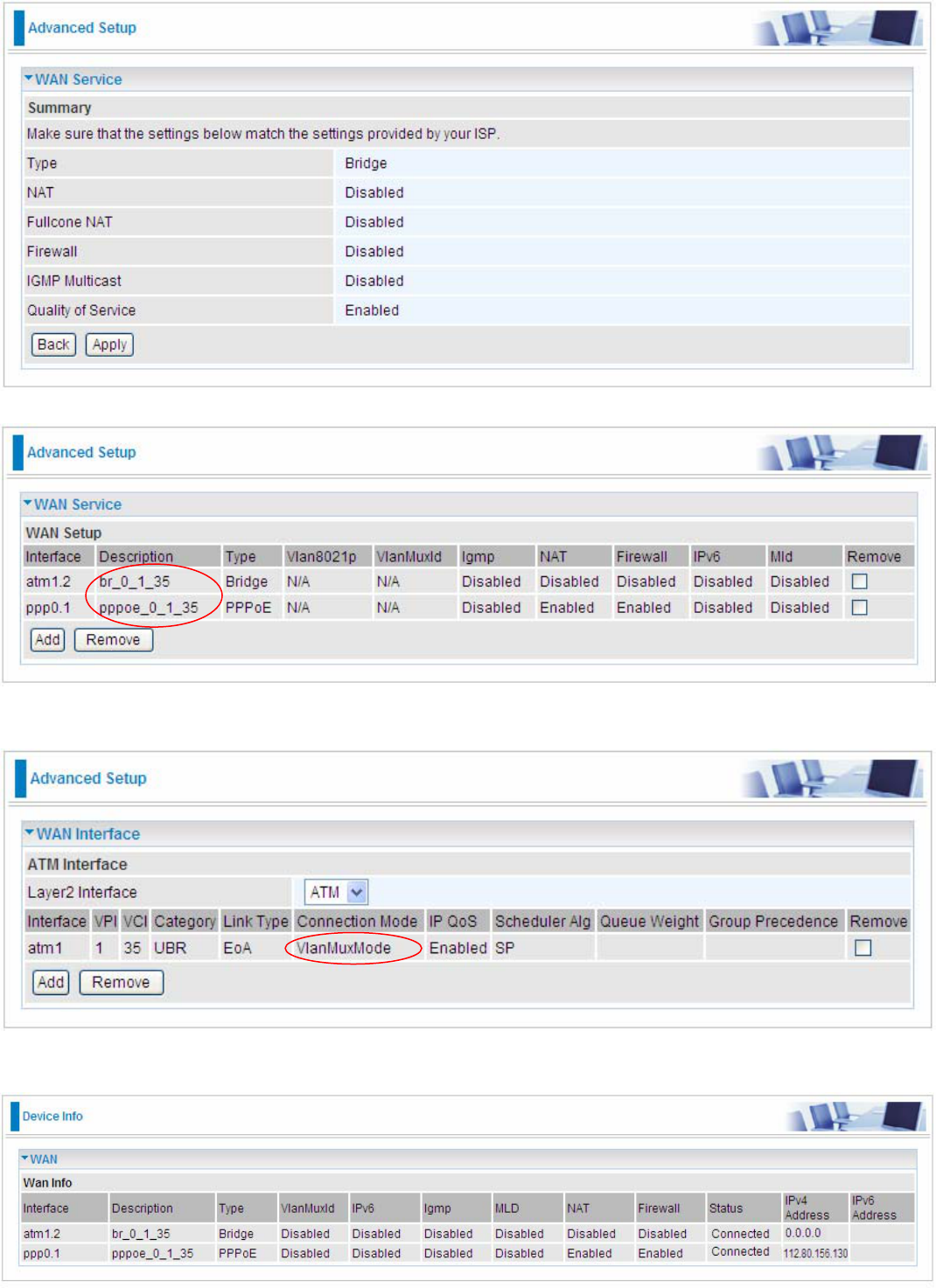
70
Click Next to make sure your settings below match the settings provided by your ISP. And Click
Apply to save your settings.
This screen is the interface we set previous, here used for understanding.
The below is WAN connection status, here you can see clearly the multiple services over one PVC.
71
See from the above diagrams, we have set one PVC, it is VPI/VCI 1/35. But we have set two
services on the same PVC, they are bridging and PPPoE services.
While in contrast to Default connection mode, one PVC can only hold one service, if you want to
more than one service over one PVC, you should apply from your ISP more PVCs to meet your
needs.
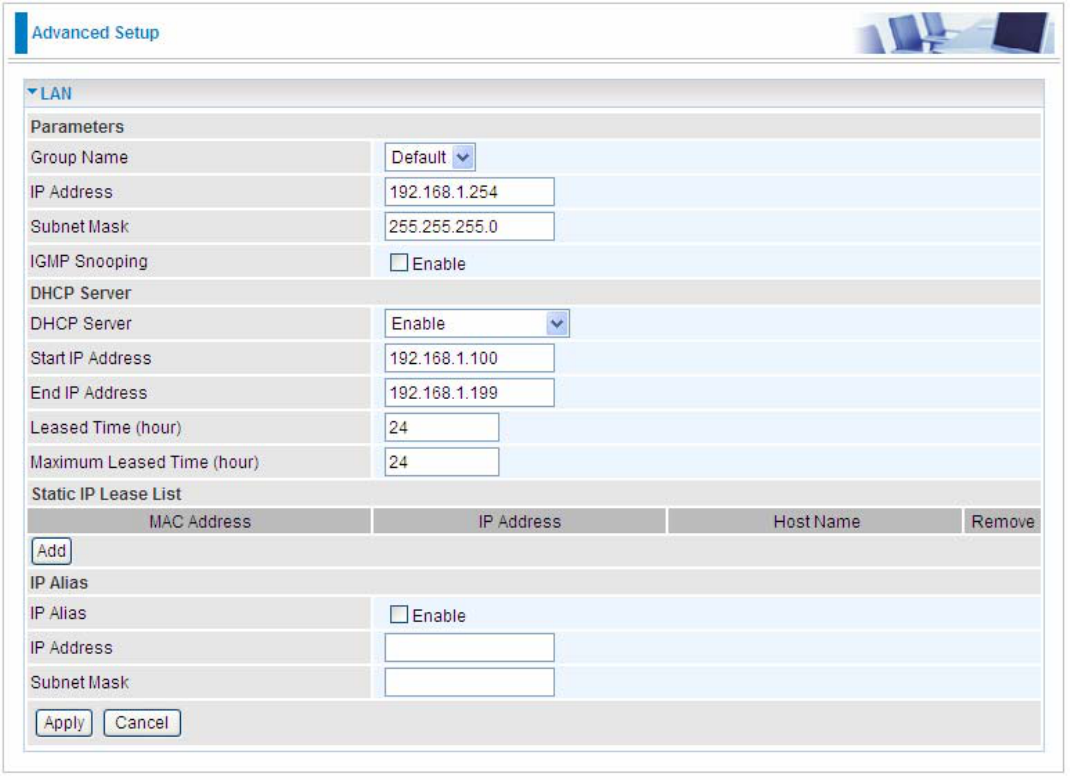
72
LAN - Local Area Network
A Local Area Network (LAN) is a shared communication system network where many computers
are connected. This type of network is area defined and is usually limited to a confined region within
a building or just within the same storey of a building.
Parameters
Group Name: here group refers to the group you set in Interface Grouping section, you can set
the parameters for the specific group. Select the group by the drop-down box. For more
information please refer to Interface Grouping of this manual.
IP address: the IP address of the router. Default is 192.168.1.254.
Subnet Mask: the default Subnet mask on the router.
IGMP Snooping: Enable or disable the IGMP Snooping function. Without IGMP snooping,
multicast traffic is treated in the same manner as broadcast traffic - that is, it is forwarded to all
ports. With IGMP snooping, multicast traffic of a group is only forwarded to ports that have
members of that group.”
When enabled, you will see two modes:
L Standard Mode: In standard mode, multicast traffic will flood to all bridge ports when no
client subscribes to a multicast group.
L Blocking Mode: In blocking mode, the multicast data will be blocked when there are no
client subscribes to a multicast group, it won’t flood to the bridge ports.
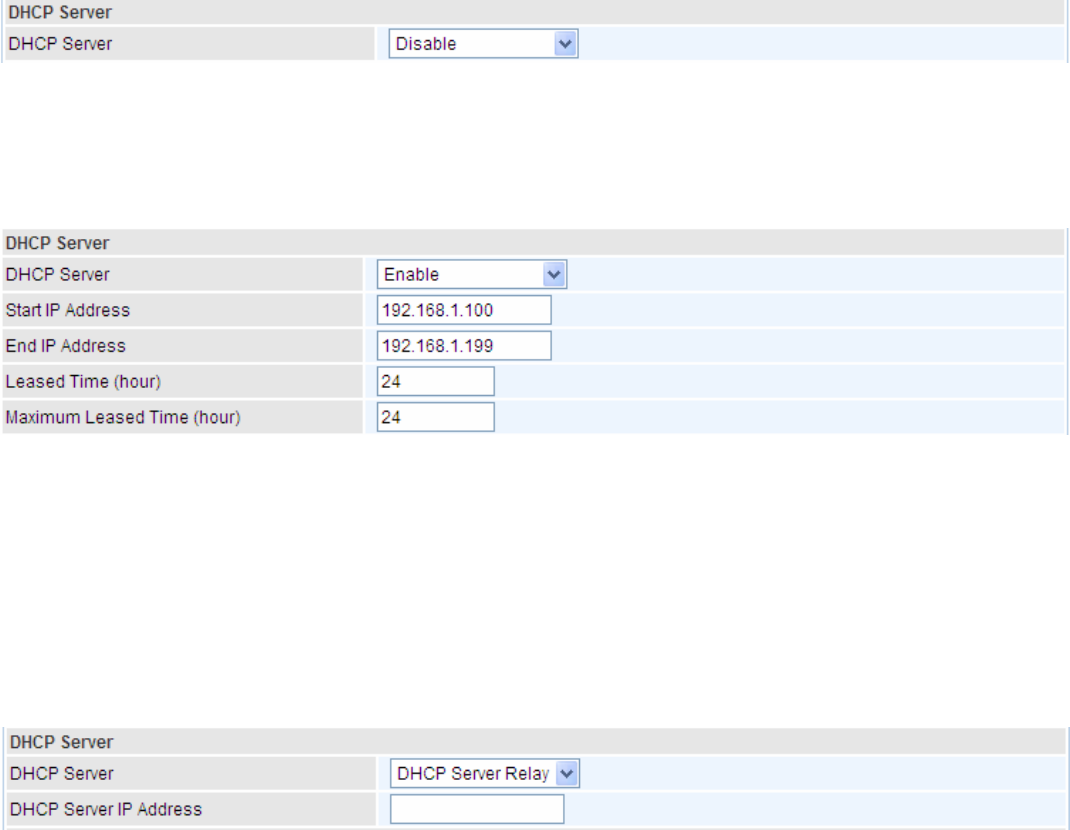
73
DHCP Server
You can disable or enable the DHCP (Dynamic Host Configuration Protocol) server or enable the
router’s DHCP relay functions. The DHCP protocol allows your router to dynamically assign IP
addresses to PCs on your network if they are configured to obtain IP addresses automatically.
L Disable
Disable the DHCP Server function.
L Enable
Enable the DHCP function, enter the information wanted. Here as default.
Start IP Address: the start IP address of the range the DHCP Server used to assign to the Clients.
End IP Address: the end IP address f the range the DHCP Server used to assign to the Clients.
Leased Time: the leased time for each DHCP Client.
Maximum Leased Time(hour): the Maximum Leased Time(hour).
L DHCP Server Relay
If you check DHCP Relay and then you must enter the IP address of the DHCP server which
assigns an IP address back to the DHCP client in the LAN. Use this function only if advised to do so
by your network administrator or ISP.
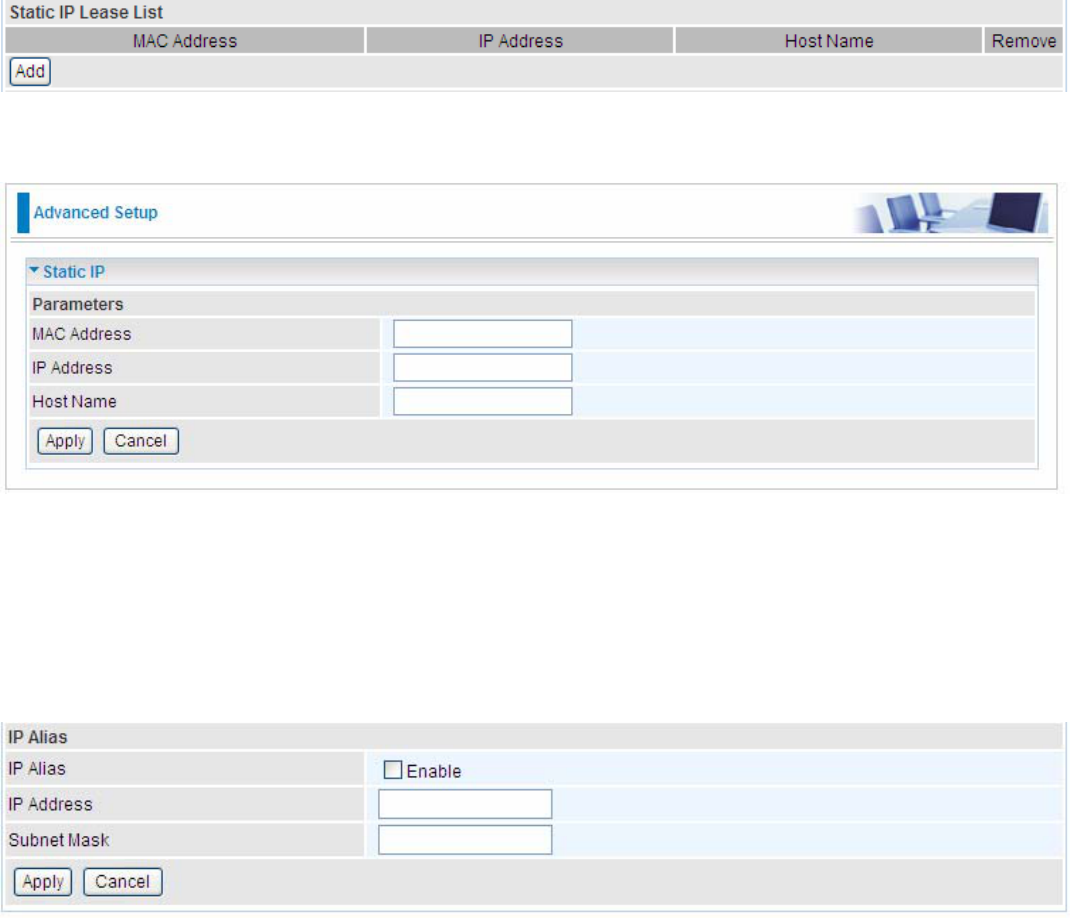
74
Static IP List
The specified IP will be assigned to the corresponding MAC Address listed in the following table
when DHCP Server assign IP Addresses to Clients.
Press Add to the Static IP List.
Enter the MAC Address, IP Address and Host Name, then click Apply to confirm your settings.
IP Alias
This function allows the creation of multiple virtual IP interfaces on this router. It helps to connect two
or more local networks to the ISP or remote node.
IP Alias: check whether to enable this function.
IP Address: Specify an IP address on this virtual interface.
Netmask: Specify a subnet mask on this virtual interface.
Click Apply to apply your settings.
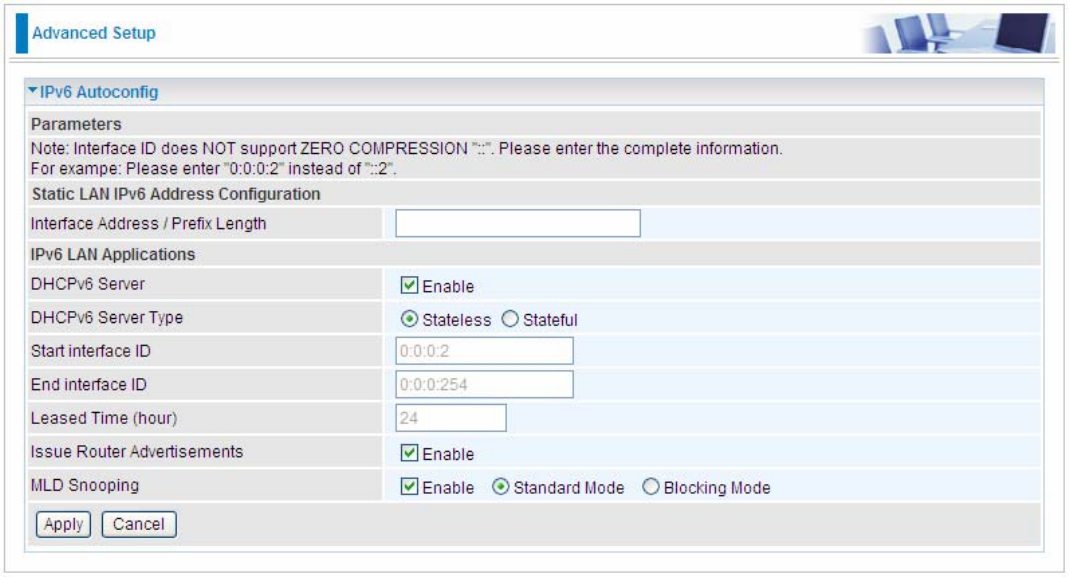
75
IPv6 Autoconfig
The IPv6 address composes of two parts, thus, the prefix and the interface ID.
There are two ways to dynamically configure IPv6 address on hosts. One is statefull configuration,
for example using DHCPv6 (which resembles its counterpart DHCP in IPv4.) In the stateful
autoconfiguration model, hosts obtain interface addresses and/or configuration information and
parameters from a DHCPv6 server. The Server maintains a database that keeps track of which
addresses have been assigned to which hosts.
The second way is stateless configuration. Stateless auto-configuration requires no manual
configuration of hosts, minimal (if any) configuration of routers, and no additional servers. The
stateless mechanism allows a host to generate its own addresses using a combination of locally
available information (MAC address) and information (prefix) advertised by routers. Routers
advertise prefixes that identify the subnet(s) associated with a link, while hosts generate an
"interface identifier" that uniquely identifies an interface on a subnet. An address is formed by
combining the two. When using stateless configuration, you needn’t configure anything on the client.
Static LAN IPv6 Address Configuration
Interface Address / Prefix Length: enter the static LAN IPv6 address.
IPv6 LAN application
DHCPv6 Server: check whether to enable DHCPv6 server.
DHCPv6 Server Type: select Stateless or Stateful. When DHCPv6 is enabled, this parameter is
available. Stateless: if selected, the PCs in LAN are configured through RA mode, thus, the PCs in
LAN are configured through RA mode, to obtain the prefix message and generate an address using
a combination of locally available information (MAC address) and information (prefix) advertised by
routers, but they can obtain such information like DNS from DHCPv6 Server. Stateful: if selected,
the PCs in LAN will be configured like in IPv4 mode, thus obtain addresses and DNS information
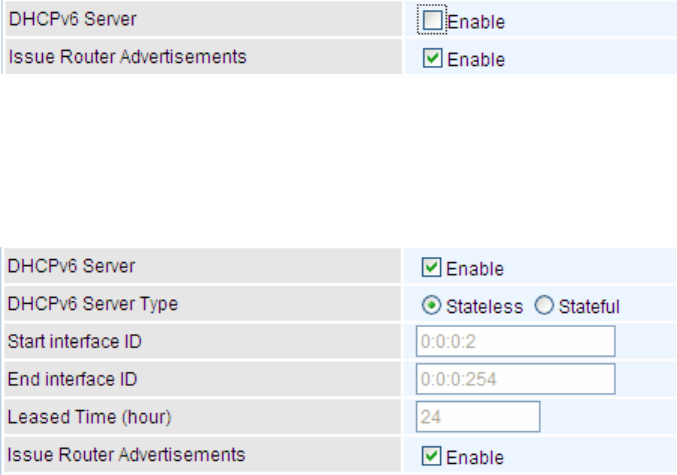
76
from DHCPv6 server.
Start interface ID: enter the start interface ID. The IPv6 address composed of two parts, thus, the
prefix and the interface ID. Interface is like the Host ID compared to IPv4.
End interface ID: enter the end interface ID.
Note: Interface ID does NOT support ZERO COMPRESSION "::". Please enter the complete
information.
For example: Please enter "0:0:0:2" instead of "::2".
Leased Time (hour): the leased time, similar to leased time in DHCPv4, is a time limit assigned to
clients, when expires, the assigned ID will be recycled and reassigned.
Issue Router Advertisement: check whether to enable issue Router Advertisement feature. It is to
send Router Advertisement messages periodically.
MLD snooping: similar to IGMP snooping, listens in on the MLD conversation between hosts and
routers by processing MLD packets sent in a multicast network, and it analyzes all MLD packets
between hosts and the connected multicast routers in the network. Without MLD snooping, multicast
traffic is treated in the same manner as broadcast traffic - that is, it is forwarded to all ports. With
MLD snooping, multicast traffic of a group is only forwarded to ports that have members of that
group.
L Standard Mode: In standard mode, multicast traffic will flood to all bridge ports when no
client subscribes to a multicast group.
L Blocking Mode: In blocking mode, the multicast data will be blocked when there is no
client subscribes to a multicast group, it won’t flood to the bridge ports.
Stateless and Stateful IPv6 address Configuration
Stateless: two methods can be adopted.
L With DHCPv6 disabled, but Issue Router Advertisement Enabled
With this method, the PCs in LAN are configured through RA mode, thus, the PCs in LAN are
configured through RA mode, to obtain the prefix message and generate an address using a
combination of locally available information (MAC address) and information (prefix) advertised by
routers.
L With both DHCPv6 and Issue Router Advertisement Enabled
With this method, the PCs’ addresses in LAN are configured like above method, but they can
obtain such information like DNS from DHCPv6 Server.
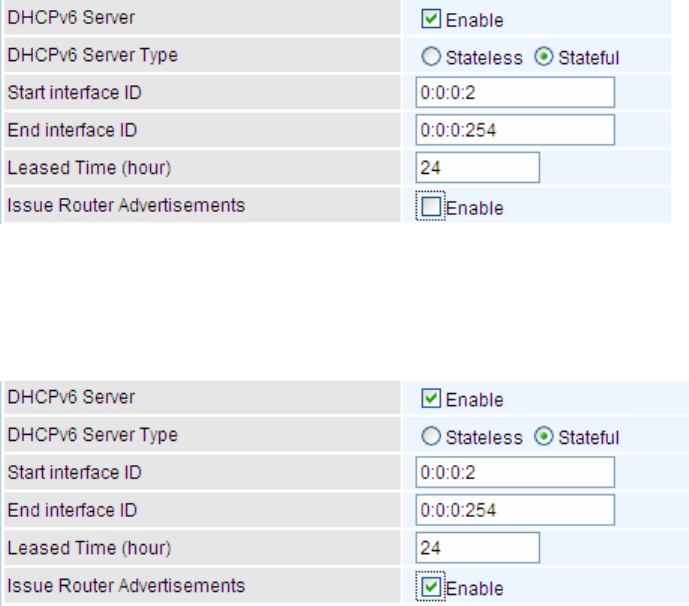
77
Stateful: two methods can be adopted.
L With only DHCPv6 enabled
With this method, the PCs’ addresses are configured the same as in IPv4, that is addresses are
assigned by DHCPv6 server.
L With both DHCPv6 and Issue Router Advertisement Enabled
With this method, the PCs’ addresses are configured the same like above, and the address
information in RA packets will be neglected.

78
NAT
NAT (Network Address Translation) feature translates a private IP to a public IP, allowing multiple
users to access the Internet through a single IP account, sharing the single IP address. It is a natural
firewall for the private network.
Virtual Servers
In TCP/IP and UDP networks a port is a 16-bit number used to identify which application program
(usually a server) incoming connections should be delivered to. Some ports have numbers that are
pre-assigned to them by the IANA (the Internet Assigned Numbers Authority), and these are referred
to as “well-known ports”. Servers follow the well-known port assignments so clients can locate them.
If you wish to run a server on your network that can be accessed from the WAN (i.e. from other
machines on the Internet that are outside your local network), or any application that can accept
incoming connections (e.g. Peer-to-peer/P2P software such as instant messaging applications and
P2P file-sharing applications) and are using NAT (Network Address Translation), then you will
usually need to configure your router to forward these incoming connection attempts using specific
ports to the PC on your network running the application. You will also need to use port forwarding if
you want to host an online game server.
The reason for this is that when using NAT, your publicly accessible IP address will be used by and
point to your router, which then needs to deliver all traffic to the private IP addresses used by your
PCs. Please see the WAN configuration section of this manual for more information on NAT.
The device can be configured as a virtual server so that remote users accessing services such as
Web or FTP services via the public (WAN) IP address can be automatically redirected to local
servers in the LAN network. Depending on the requested service (TCP/UDP port number), the
device redirects the external service request to the appropriate server within the LAN network.
This part is only available when NAT is enabled.
It is virtual server listing table as you see, Click Add to configure.
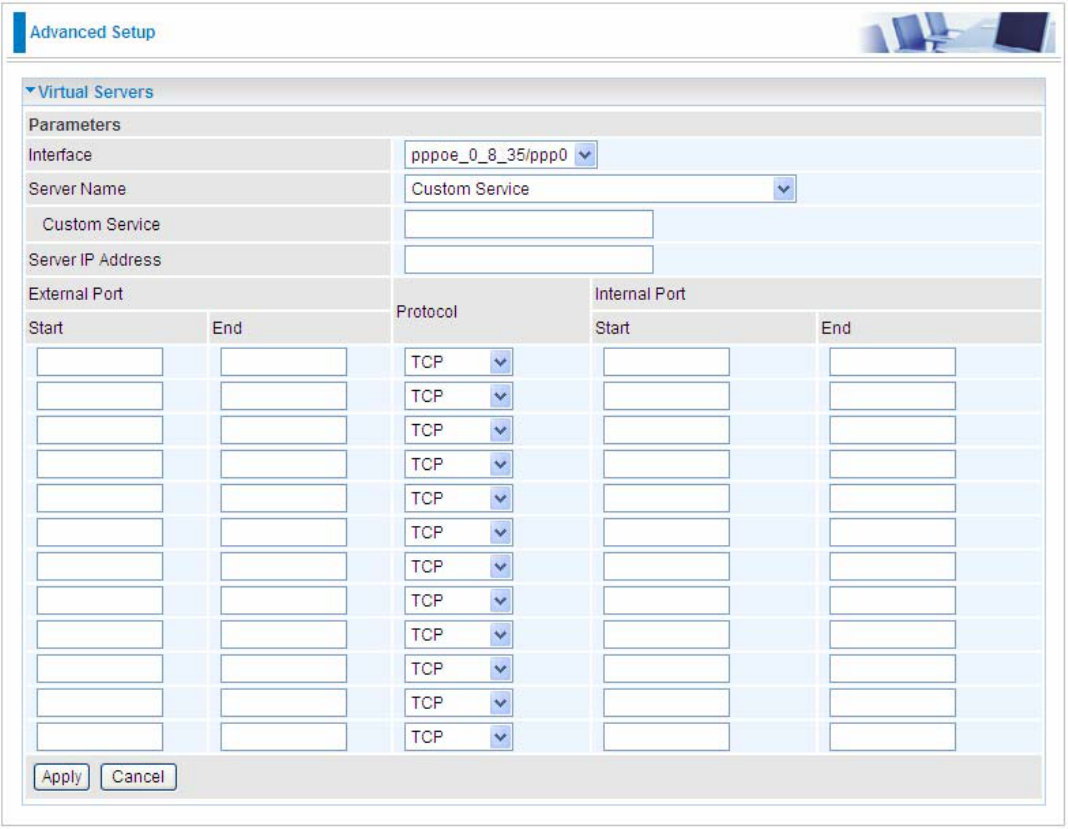
79
The following configuration page will appear to let you configure.
Interface: select from the drop-down menu the interface you want the virtual server(s) applies to.
Server Name: select the server name from the drop-down menu.
Custom Service: it is a kind of service to let users customize the service they want. Enter the user-
defined service name here. It is a parameter only available when users select Custom Service in
the above parameter.
Server IP Address: Enter your server IP Address here.
External Port
L Start: Enter a port number as the external starting number for the range you want to give
access to internal network.
L End: Enter a port number as the external ending number for the range you want to give
access to internal network.
Internal Port
L Start: Enter a port number as the internal staring number.
L End: Here it will generate automatically according to the End port number of External port
and can’t be modified.
Protocol: select the protocol this service used: TCP/UDP, TCP, UDP.
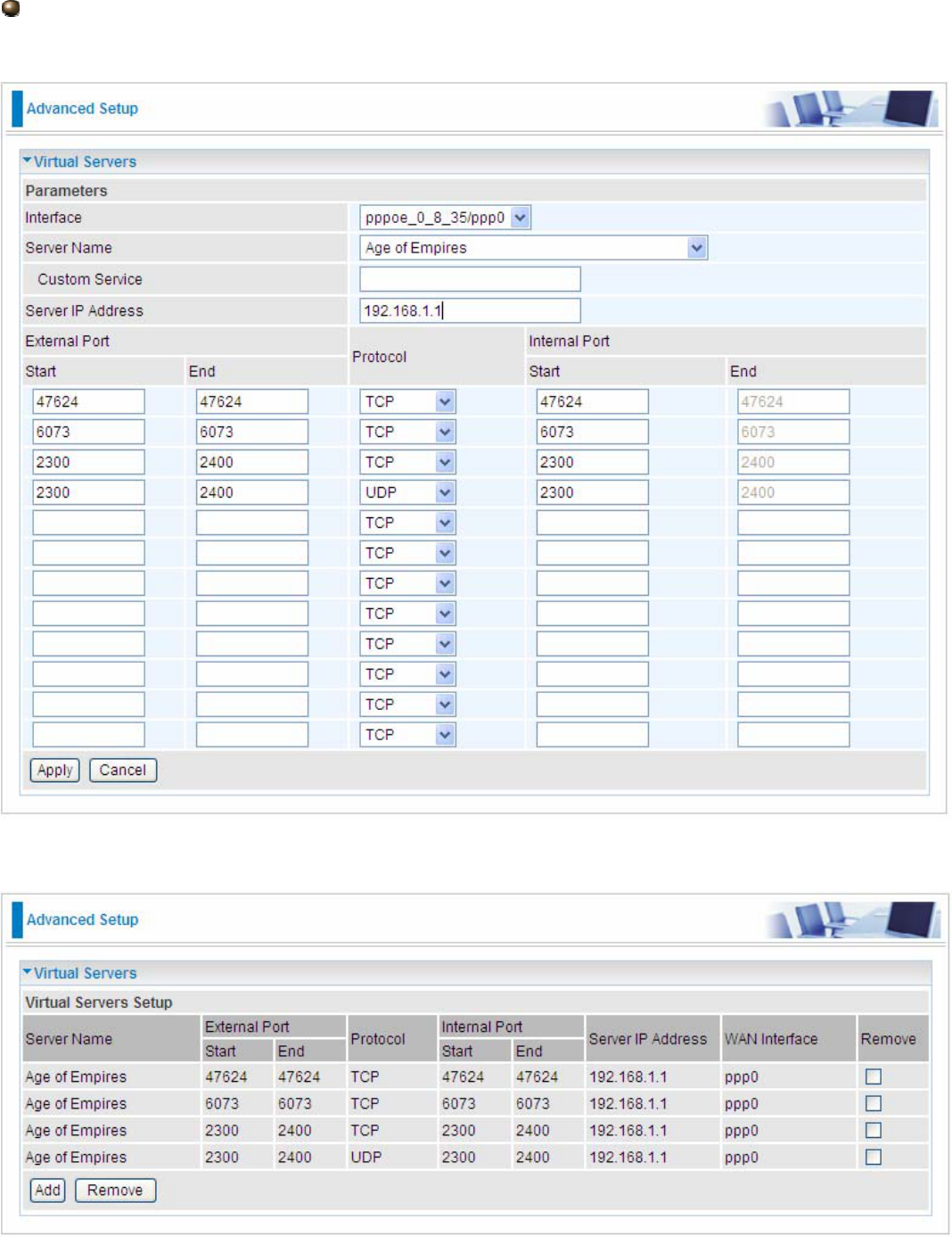
80
Set up
1. Select a Server Name from the drop-down menu, then the port will automatically appear, modify
some as you like, or you can just leave it as default. Remember to enter your server IP Address.
2. Press Apply to conform, and the items will be list in the Virtual Servers Setup table.
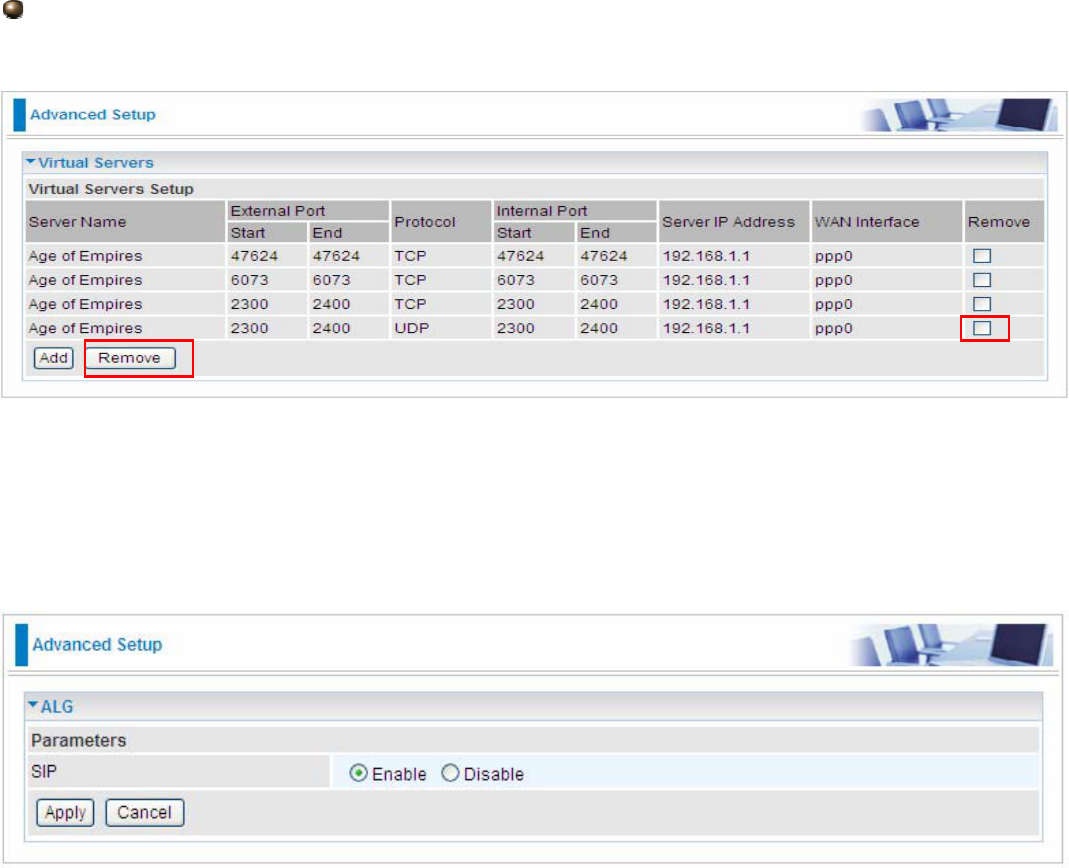
81
Remove
If you don’t need a specified Server, you can remove it. Check the check box beside the item you
want to remove, then press Remove, it will be OK.
ALG
The ALG Controls enable or disable protocols over application layer.
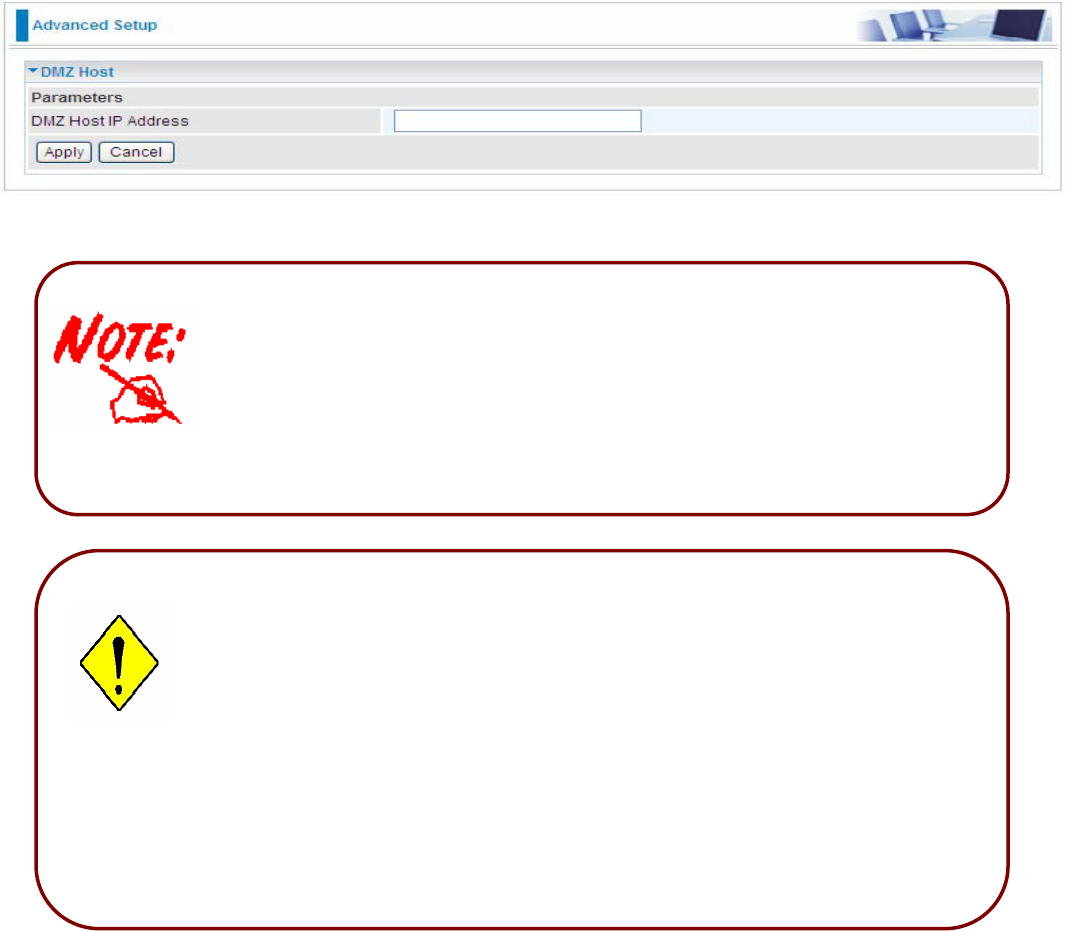
82
DMZ Host
The DMZ Host is a local computer exposed to the Internet. When setting a particular internal IP
address as the DMZ Host, all incoming packets will be checked by the Firewall and NAT algorithms
then passed to the DMZ host, when a packet received does not use a port number used by any
other Virtual Server entries.
DMZ Host IP Address: Enter the IP Address of a host you want it to be a DMZ host.
Using port mapping does have security implications, since outside users are
able to connect to PCs on your network. For this reason you are advised to use
specific Virtual Server entries just for the ports your application requires instead
of simply using DMZ or creating a Virtual Server entry for “All” protocols, as
doing so results in all connection attempts to your public IP address accessing
the specified PC.
If you have disabled the NAT option in the WAN-ISP section, the Virtual Server
function will hence be invalid.
If the DHCP server option is enabled, you have to be very careful in assigning
the IP addresses of the virtual servers in order to avoid conflicts. The easiest way
of configuring Virtual Servers is to manually assign static IP address to each
virtual server PC, with an address that does not fall into the range of IP
addresses that are to be issued by the DHCP server. You can configure the
virtual server IP address manually, but it must still be in the same subnet as the
router.
Attention
